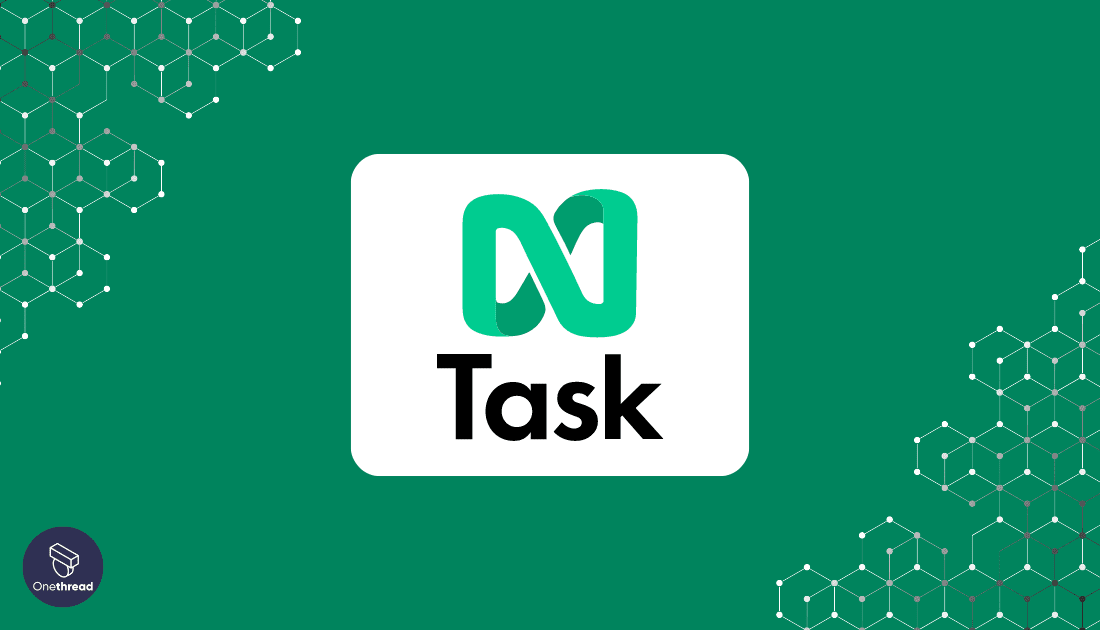In the bustling world of project management, nTask has emerged as a multifaceted tool that boasts an impressive range of functionalities. Yet, you and I both know that finding the perfect fit for your team’s unique needs might require exploring alternatives.
Fear not, for we’re embarking on a journey to uncover the top 10 nTask alternatives of 2023, tailored for those looking to streamline their workflow even further. Let’s dive into an insightful comparison to find a solution that resonates with your project management needs.
Our reviewers evaluate software independently. Clicks may earn a commission, which supports testing. Learn how we stay transparent & our review methodology
Quick List of nTask Alternatives
- Onethread: Seamless integration and collaboration with real-time communication for effective project management.
- Trello: Card-based interface simplifies tracking and collaboration, making projects manageable.
- Asana: Intuitive design meets powerful functionality, providing clarity and ease for complex tasks.
- Monday.com: Visual, transparent task management engaging teams at any project complexity.
- Wrike: Flexible platform adapts to specific needs, ensuring success for every project.
- ClickUp: All-in-one solution with extensive features, consolidating project management.
- Jira: Crafted for Agile teams, offers customizable workflows and adaptability.
- Zoho Projects: Emphasizes automation and analytics, translating data into actionable insights.
- Basecamp: Straightforward design with robust communication tools, valuing simplicity and functionality.
- Smartsheet: Automation and real-time collaboration for flexible alignment with diverse methodologies.
Our reviewers evaluate software independently. Clicks may earn a commission, which supports testing. Learn how we stay transparent & our review methodology
What is nTask?
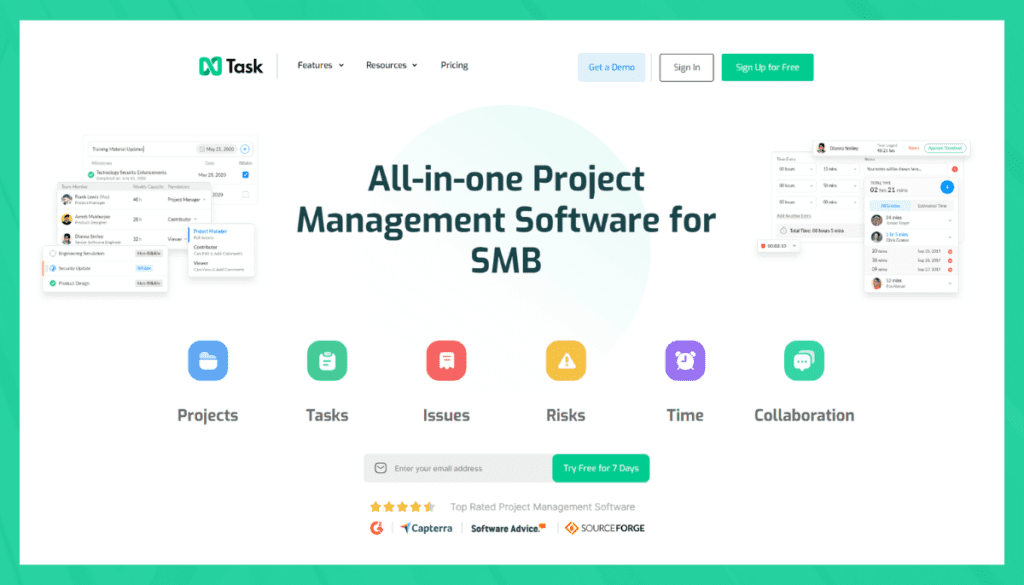
nTask is a comprehensive project management tool designed to streamline task management, collaboration, and communication within teams.
Founded with the intention of addressing the complexities of project management, nTask emerged as a solution to help individuals and teams stay organized and efficient. Its features allow teams to create tasks, assign responsibilities, set due dates, track time spent on tasks, and collaborate seamlessly.
Additionally, nTask offers integration with various popular tools like Slack, Google Drive, and Dropbox, enhancing its usability and adaptability to different workflows.
Its user-friendly design, affordability, and versatile feature set make it a preferred choice for small to medium-sized businesses seeking an all-in-one project management solution.
Reasons to Consider an Alternative to nTask
While nTask offers valuable features, there are scenarios where businesses might find alternatives more suitable due to specific needs and challenges.
- Complex Project Requirements
For businesses handling large, intricate projects, alternatives with more advanced project planning and resource management capabilities might be preferred.
- Industry-Specific Demands
Industries with unique compliance or workflow requirements may benefit from specialized project management tools tailored to their needs.
- Integration Ecosystem
If a company heavily relies on a specific set of tools that aren’t seamlessly integrated with nTask, they might explore alternatives that offer better interoperability.
- Scalability Concerns
Growing businesses might need a solution that can scale along with their expansion, including accommodating more users, projects, and data without performance issues.
- Advanced Reporting and Analytics
Companies seeking in-depth insights into project performance and team productivity might opt for alternatives that offer more sophisticated reporting and data analysis features.
- Customization and Flexibility
Businesses requiring a high degree of customization in workflows and task structures might explore alternatives that offer greater flexibility in adapting to their specific processes.
Customer Ratings
- G2: 4.4 (17 reviews)
- Capterra: 4.2 (104 reviews)
Top 10 nTask Competitors At a Glance
Tool | Collaboration Description | Task Management Description | Task Tracking Description | Workflow Automation Description |
 | Collaboration tools for effective communication and information sharing. | Unified task management with priority and status tracking. | Comprehensive task tracking with detailed notes. | Automation of recurring tasks and task assignments. |
 | Discussion, chat, and document sharing for collaboration | Thread-based task assignment and comment feature | Real-time tracking, kanban board view | Customizable workflows for tailored efficiency. |
 | Visual collaboration through shared boards and cards for teamwork. | Task tracking using cards to promote transparency. | Card-based task tracking for easy visualization. | Kanban-style workflows for task progression. |
 | Unified environment for teams to communicate and manage tasks effectively. | Task management with assignments and due dates for organization. | Progress tracking through milestones and Gantt charts. | Task dependency management and automation for efficiency. |
 | Collaborative project management with task assignments and communication. | Familiar spreadsheet-style task management for teams. | Cell-based progress tracking for visibility. | Automated workflows with alerts and reminders. |
 | Shared workspaces for team collaboration on tasks and project progress. | Structured task management with assignment and prioritization. | Detailed task tracking with customizable fields. | Automation rules for task assignment and notifications. |
 | Project workspaces for collaborative organization and task tracking. | Centralized task management for organized execution. | Task tracking within projects for status updates. | Workflow customization for team-specific needs. |
 | Collaborative workspace for real-time information sharing and task updates. | Visual task management for streamlined collaboration. | Timeline-based task tracking for project overview. | Automation recipes for repetitive task workflows. |
 | Customizable platform for teams to collaborate and manage tasks together. | Versatile task management tools for diverse project needs. | Comprehensive task tracking for streamlined progress. | Automation features for workflow optimization. |
 | Collaborative hub for communication, file sharing, and task coordination. | Simplified task lists for clear management and delegation. | To-do lists and progress tracking for projects. | Calendar-based scheduling and automated check-ins. |
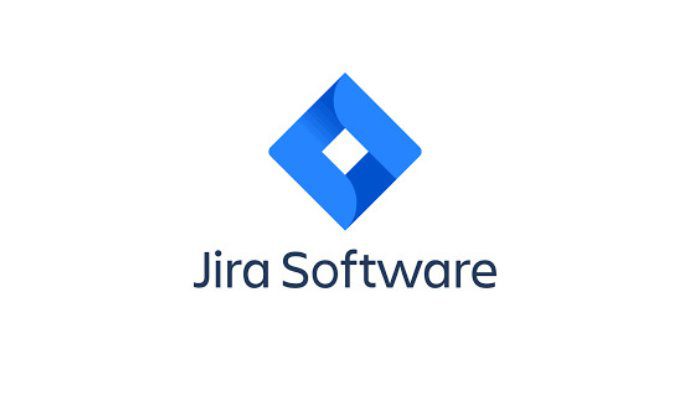 | Agile methodologies and tools for team collaboration on tasks and projects. | Agile task management for iterative development processes. | User story tracking and sprint progress monitoring. | Custom workflows and automation for Agile processes. |
Top 10 nTask Alternatives for Your Project Management Needs
When evaluating project management tools, it’s essential to consider various alternatives to nTask to ensure you find the best fit for your specific requirements. While nTask offers valuable features, here are 10 alternatives that cater to diverse project management needs.
Onethread

Onethread is rapidly gaining recognition in the world of project management for its emphasis on real-time collaboration and integration. What sets this tool apart is its innate ability to foster communication within teams, making complex tasks seem less intimidating.
With Onethread, project managers can expect streamlined processes, better visibility across tasks, and enhanced productivity, all bundled within a user-friendly interface.
Key Features of Onethread
Certainly, here’s a more detailed description of each key feature of Onethread:
Real-time Collaboration
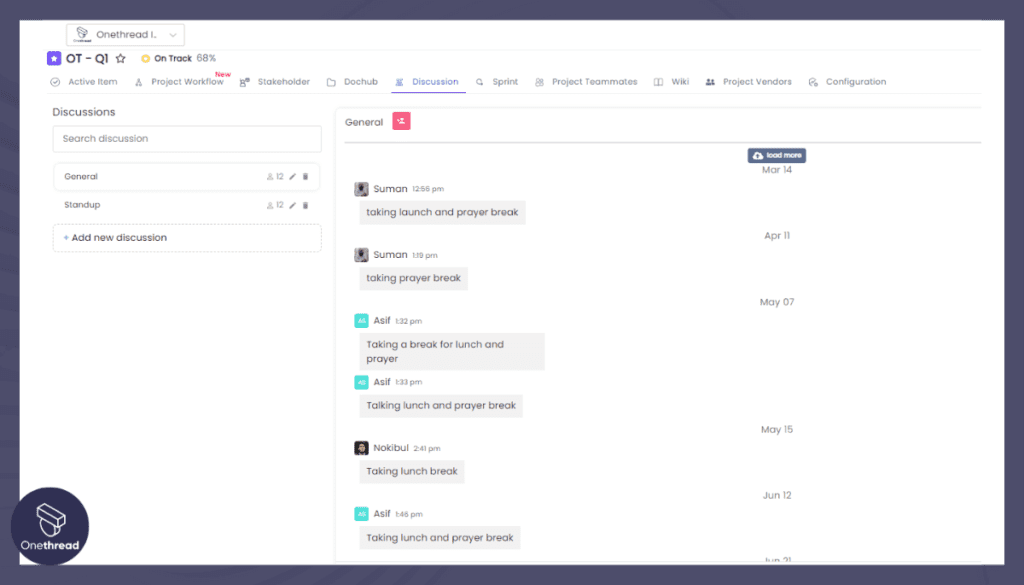
Onethread’s real-time collaboration feature goes beyond traditional communication tools. It provides a virtual workspace where team members can interact, brainstorm, and work together on tasks simultaneously.
Whether it’s discussing project details, sharing ideas, or making updates, this feature ensures that every team member is on the same page at all times.
Customizable Workflows
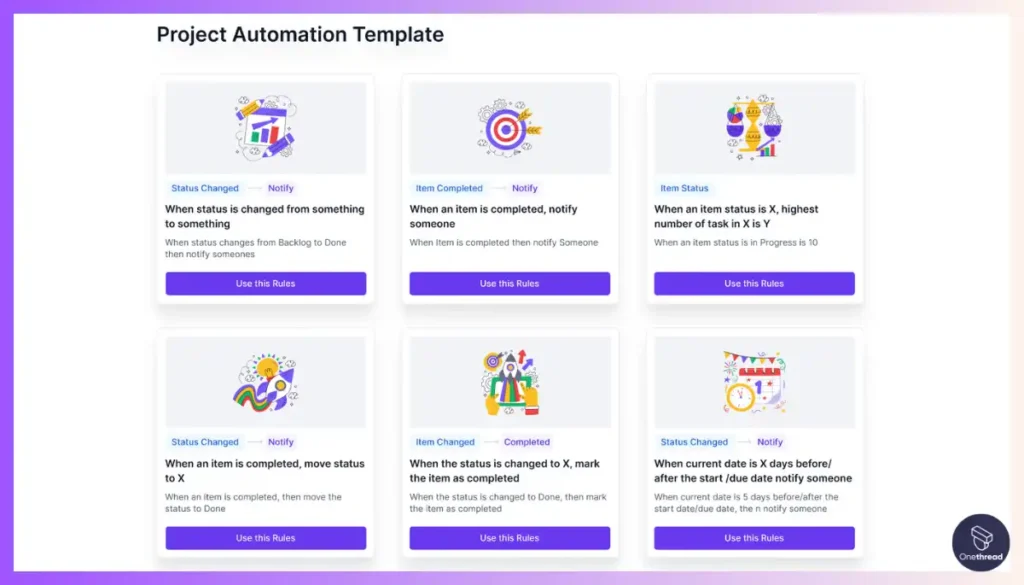
Onethread’s customizable workflows empower teams to tailor the platform to their unique project processes. This level of customization allows teams to align the tool with their preferred methodologies, ensuring a seamless fit within existing workflows.
By offering adaptable templates and the ability to define task dependencies, statuses, and triggers, teams can create workflows that mirror their real-world operations, leading to smoother project execution and minimized process friction.
Visual Project Tracking
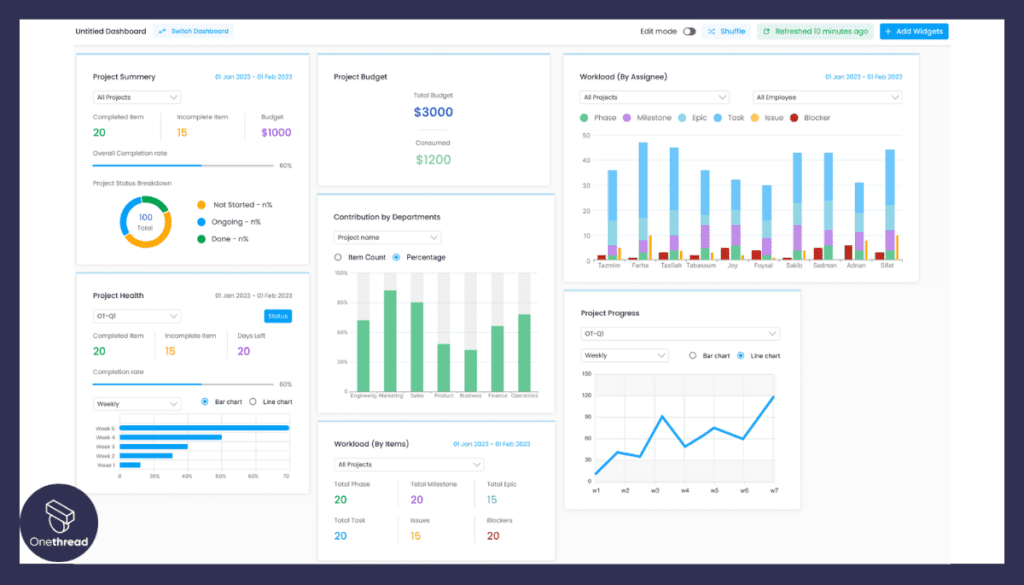
The visual project tracking feature provides an interactive and visually appealing way to monitor project progress. Through interactive dashboards, Gantt charts, and visual timelines, teams can gain an instant overview of project status, identify potential bottlenecks, and spot trends.
This visual representation enhances decision-making, allowing teams to make informed adjustments and prioritize tasks effectively. This feature is particularly beneficial for understanding task relationships, dependencies, and critical path analysis.
Centralized Document Management
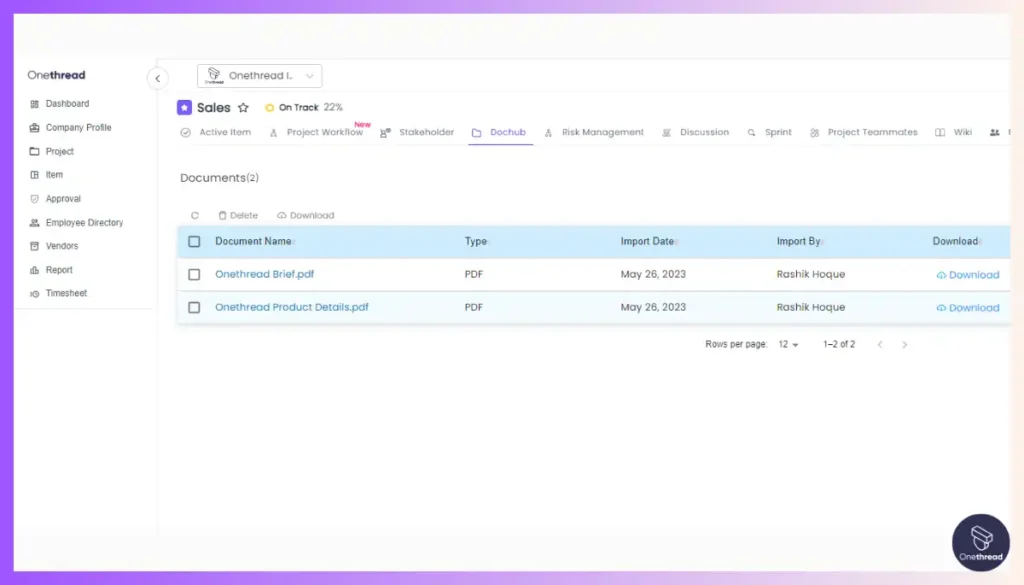
Centralized document management simplifies file storage and access. All project-related documents, assets, and resources are stored in a single location within the platform. This feature reduces the need to search through scattered folders or rely on external file-sharing tools.
By providing a unified repository, teams can easily find, share, and collaborate on documents, ensuring data consistency and minimizing the risk of outdated information.
Task Automation
Onethread’s task automation feature streamlines routine tasks, freeing up team members to focus on more strategic and value-added activities. Through predefined workflows and triggers, repetitive tasks are automatically executed, reducing manual intervention and the likelihood of errors.
This automation not only increases productivity but also maintains consistency in task execution across projects, leading to improved project outcomes.
Performance Analytics
Performance analytics deliver actionable insights into team productivity, task progress, and project health. Teams can track key performance indicators (KPIs), analyze trends, and generate custom reports.
By leveraging data-driven insights, teams can make informed decisions, allocate resources more effectively, and identify areas for improvement. This feature transforms raw data into actionable information, driving continuous enhancement in project execution and team performance.
Collaboration Tools
Onethread’s collaboration tools encompass a range of features such as real-time chat, file sharing, and task assignment. These tools promote seamless communication and coordination among team members. Real-time chat facilitates instant discussions, while file sharing ensures efficient document exchange.
Task assignment allows for clear accountability and visibility into task ownership. These collaborative features foster a cohesive work environment, where team members can collectively contribute to project success.
Best Use Cases of Onethread
- Collaboration: Facilitates seamless team interaction.
- Communication: Enhances information exchange across team members.
- Task Management: Streamlines task organization and tracking.
- Performance Monitoring: Allows for constant evaluation and improvement.
- Workflow Customization: Tailors the platform to unique project needs.
Why Should You Choose Onethread over nTask?
In comparison to nTask, Onethread offers distinctive benefits such as enhanced real-time collaboration and more customizable workflows. It provides a feature-rich yet simplified experience that resonates with various project needs.
Feature | Onethread | nTask |
Real-time Collaboration | ✓ | ✗ |
Customizable Workflows | ✓ | ✓ |
Visual Project Tracking | ✓ | ✗ |
Centralized Documents | ✓ | ✓ |
Task Automation | ✓ | ✓ |
Performance Analytics | ✓ | ✗ |
Pros of using Onethread
- Seamless real-time collaboration
- Flexibility in customization
- Visual aids for project tracking
- Robust performance analytics
Cons of using Onethread
- Might require initial training
- Limited integration with some third-party tools
Pricing

- Basic Plan: Free for small teams
- Growth Plan: $3.6 per user/month
- Scale Plan: $6 per user/month
Trello
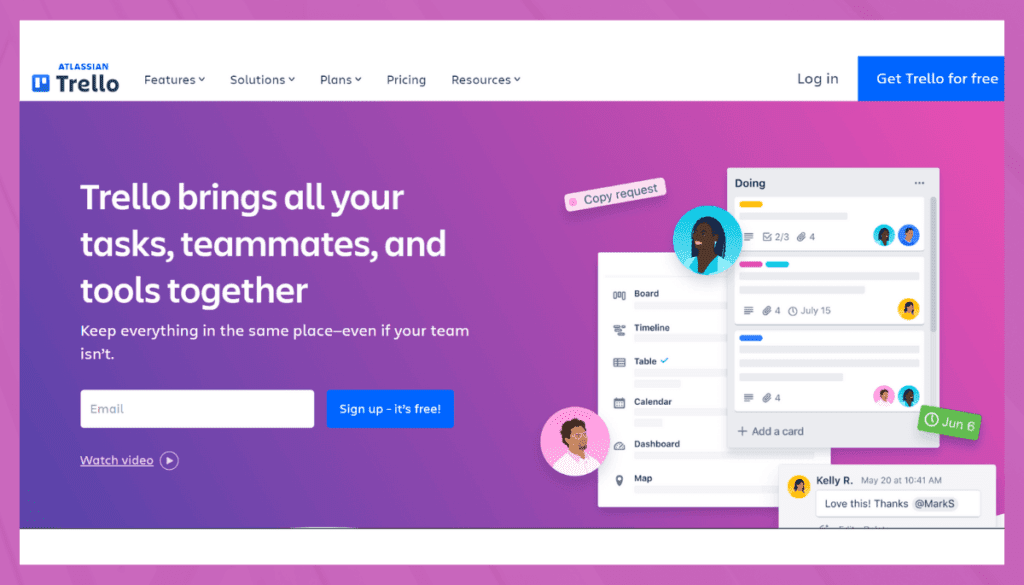
Trello is a well-known project management tool that uses a card-based system to organize tasks and projects. With its intuitive and visual approach, it has become popular among diverse teams for its ease of use and flexibility.
The benefits include enhanced collaboration, simplicity in tracking progress, and straightforward implementation.
Features of Trello
Kanban Boards
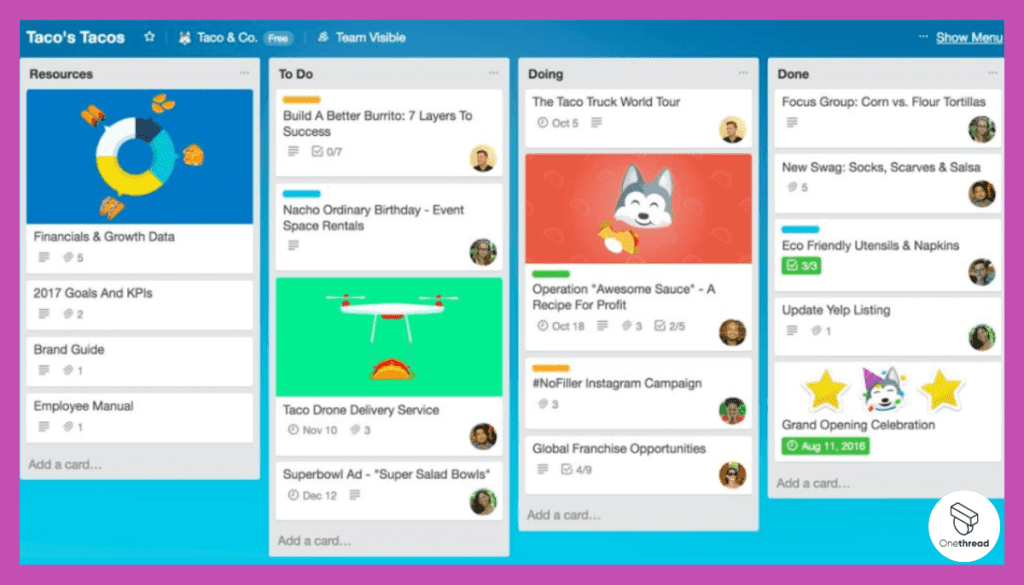
Trello’s signature feature is its Kanban boards. These boards provide a visual representation of your project’s workflow. Each board consists of columns that represent different stages of your process (e.g., “To Do,” “In Progress,” “Done”).
Tasks are represented as cards that move across columns as they progress. This visual overview enhances clarity by giving team members a clear snapshot of tasks.
Customizable Cards
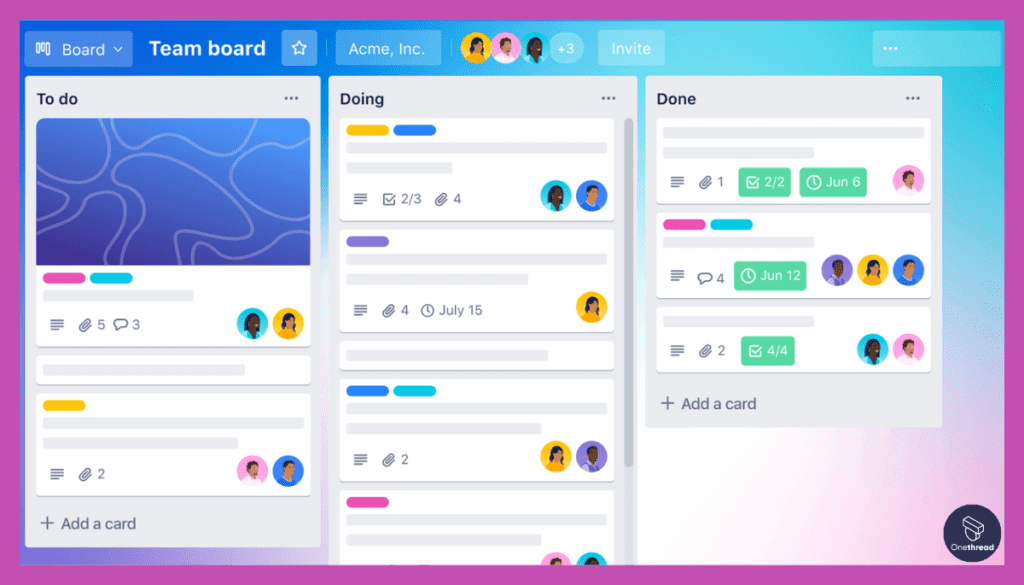
Within each board, tasks are represented as customizable cards. These cards act as mini task hubs. You can attach due dates, labels, attachments, comments, checklists, and more to each card.
This customization empowers you to capture and organize all the relevant information for a task in one place. As a result, tasks become more manageable, and team members have a central location to find all the details they need.
Collaboration Tools
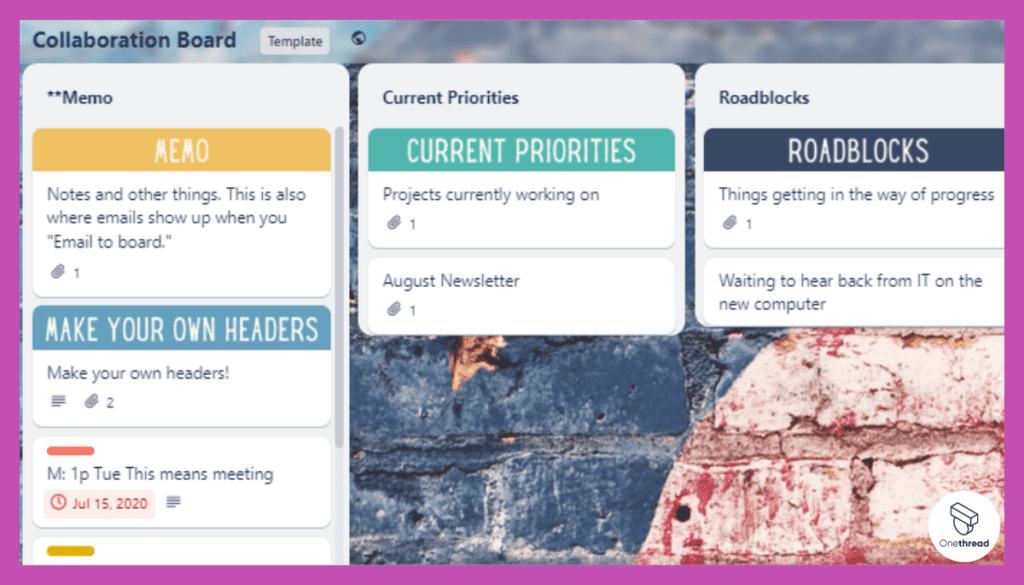
Trello’s collaboration tools are designed to foster real-time communication among team members. You can add comments to cards, mentioning specific team members to bring their attention to important updates or questions. This keeps discussions contextual and prevents the need for separate email chains.
Integrations
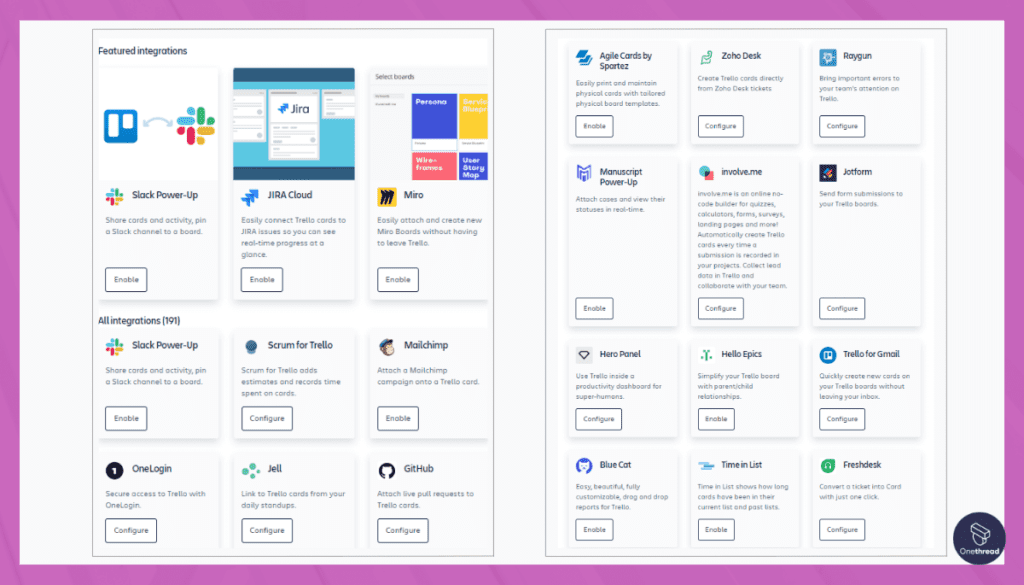
Trello integrates seamlessly with a wide array of third-party apps and services. These integrations enable you to connect Trello with tools you already use, such as Google Drive, Slack, Jira, and more.
By linking Trello with your preferred tools, you streamline your workflow and consolidate information, ensuring that data flows smoothly across platforms.
Pros and Cons of Using Trello
Pros
- User-friendly interface
- Flexible and customizable
- Excellent for visual project tracking
- Integrates well with other tools
Cons
- Might lack advanced features for complex projects
- Limited reporting capabilities
Customer Ratings
- G2: 4.4 (13,352+ reviews)
- Capterra: 4.5 (22,68+ reviews)
Pricing
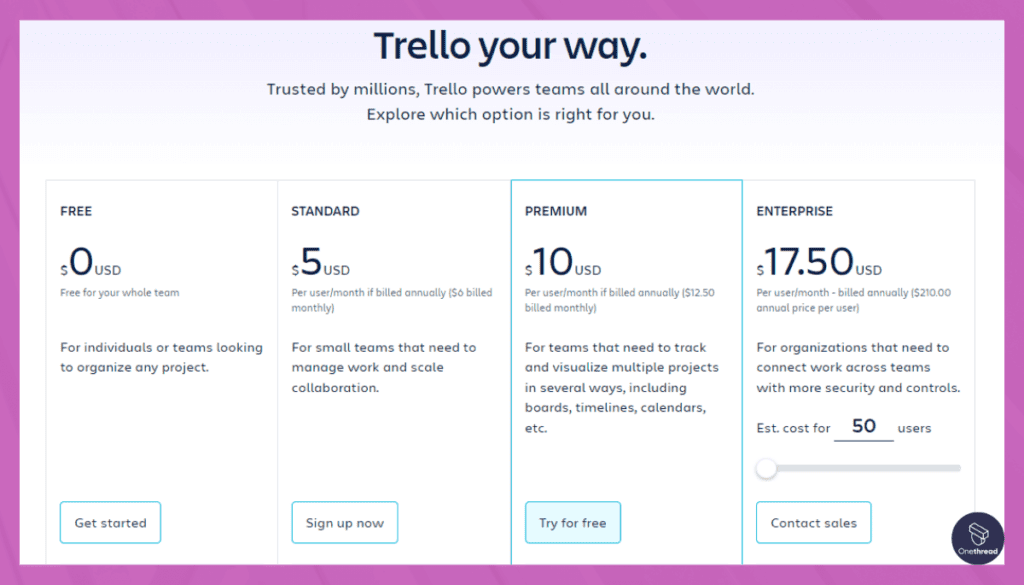
- Free Plan: Basic features for individuals and small teams
- Business Class: $10/user/month, with advanced features and priority support
- Enterprise Plan: Custom pricing for larger organizations with specific needs
Is Trello Better than nTask?
Trello’s like digital sticky notes for simple task and project management. It’s user-friendly, great for smaller teams, and emphasizes visual organization.
However, it lacks advanced features like task dependencies and Gantt charts for complex projects. nTask, on the other hand, offers a comprehensive toolbox, from task management to risk tracking.
It’s ideal for more intricate projects, with features like task dependencies, Gantt charts, and advanced collaboration. So, if you’re after simplicity, go Trello; for robust project management, nTask’s your versatile go-to.
Our Review of Trello
Trello stands out as a project management tool for its simplicity and visually intuitive design. Its accessibility and collaboration features make it a favorite among varied teams.
Though it may fall short in handling very complex projects, its versatility makes it an attractive option for those who prioritize visual tracking and straightforward collaboration.
Overall, Trello is a strong contender for teams looking to streamline their project management process.
Asana
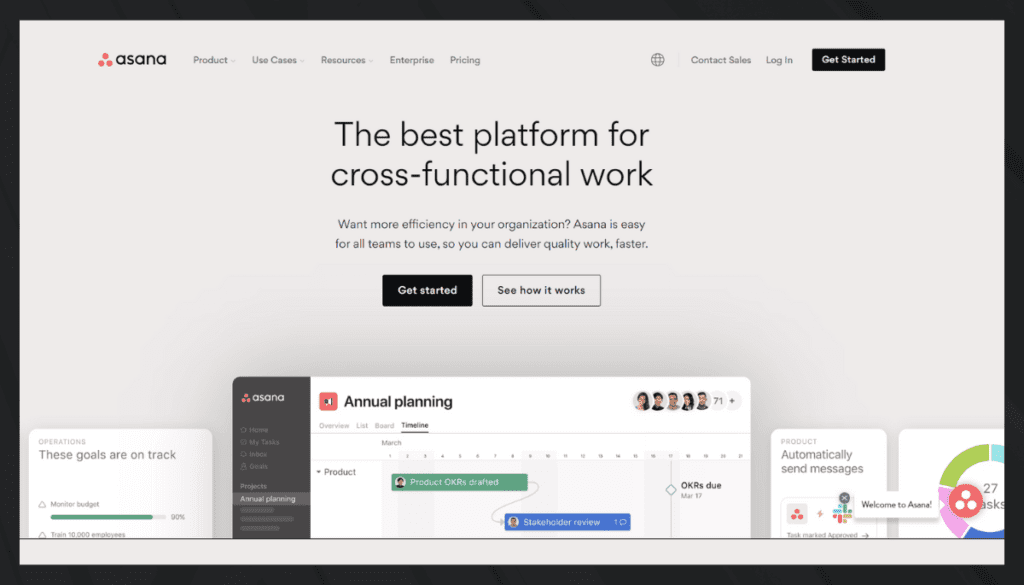
Asana is a popular project management tool designed to help teams organize, track, and manage their work. Known for blending intuitive design with powerful functionality, it enables a clearer understanding of project goals and individual responsibilities.
Asana’s benefits encompass ease of collaboration, customizable workflows, and a broad range of features that cater to both simple and complex projects.
Features of Asana
Task Management
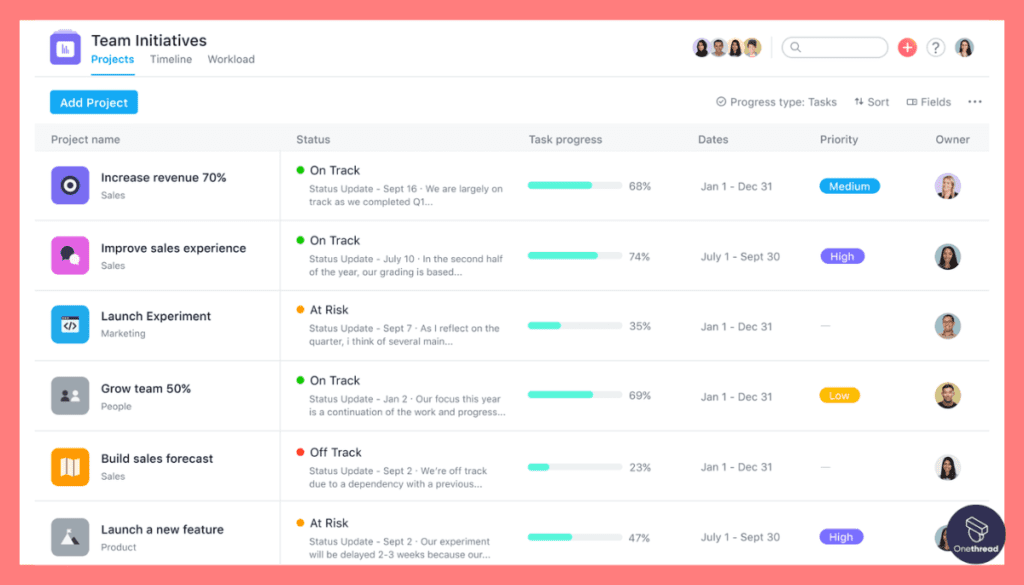
Asana’s task management capabilities empower teams to create, assign, and organize tasks efficiently. With task assignments, team members know exactly what’s expected of them, reducing confusion and ensuring accountability. The ability to set due dates and priorities helps manage workloads effectively and meet project deadlines.
Timeline View
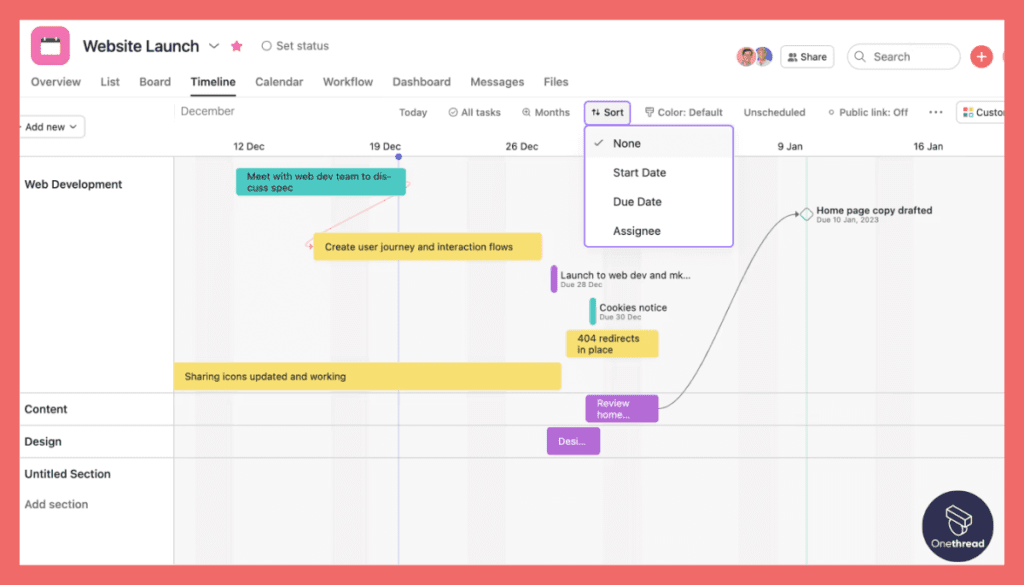
Asana’s timeline view provides a visual representation of project progress over time. This feature is particularly useful for understanding task dependencies, identifying potential bottlenecks, and optimizing project schedules. The timeline view allows teams to visualize how tasks are interconnected and adjust plans accordingly.
Workspaces and Portfolios
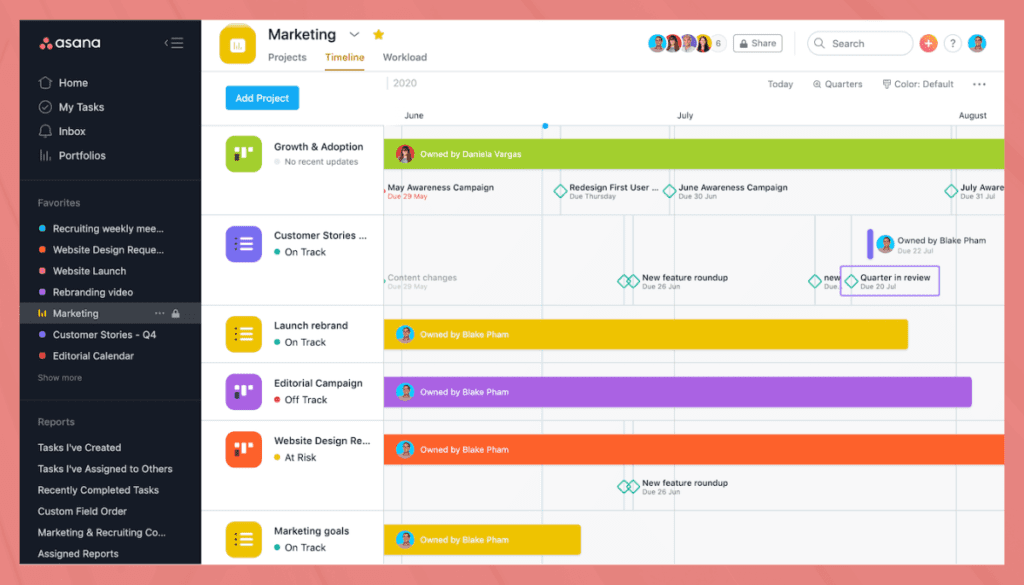
Workspaces and portfolios in Asana offer a structured way to manage multiple projects concurrently. Workspaces enable teams to organize tasks, teams, and projects based on different areas or departments.
Portfolios provide a higher-level view of multiple projects, allowing stakeholders to track progress, align goals, and allocate resources effectively.
Automation and Rules
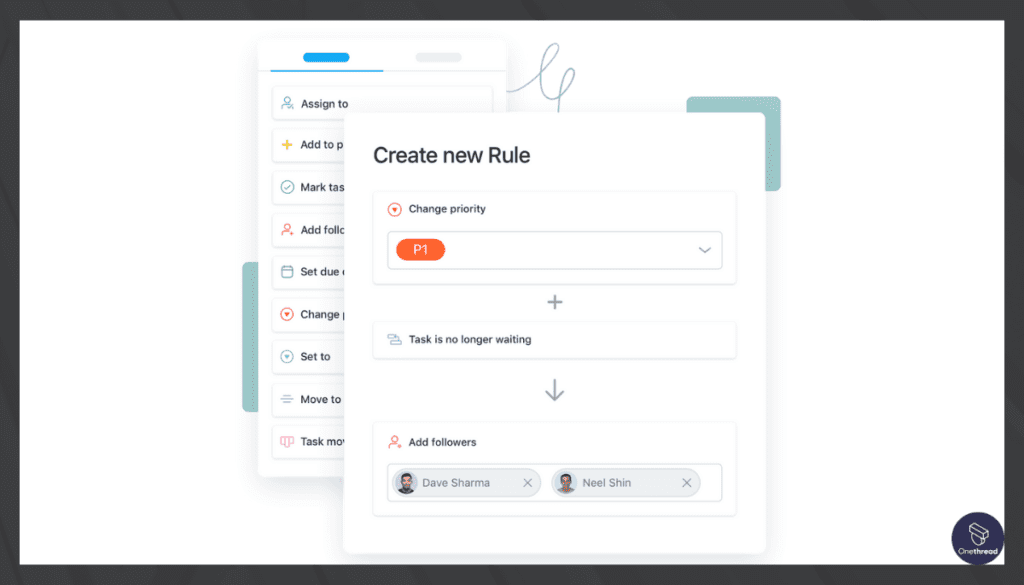
Asana’s automation capabilities streamline workflows by automating repetitive tasks and setting up rules that trigger specific actions based on predefined conditions.
This saves time and reduces manual effort, allowing team members to focus on strategic and creative aspects of their work. Automation ensures consistency and reduces the risk of human error.
Pros and Cons of Using Asana
Pros
- Versatile and customizable
- Offers robust tracking and reporting features
- Integrates with various third-party tools
- Suitable for various project sizes
Cons
- Can be overwhelming for new users
- Higher-tier plans can be costly
Customer Ratings
- G2: 4.3 (9,443+ reviews)
- Capterra: 4.5 (12,086+ reviews)
Pricing
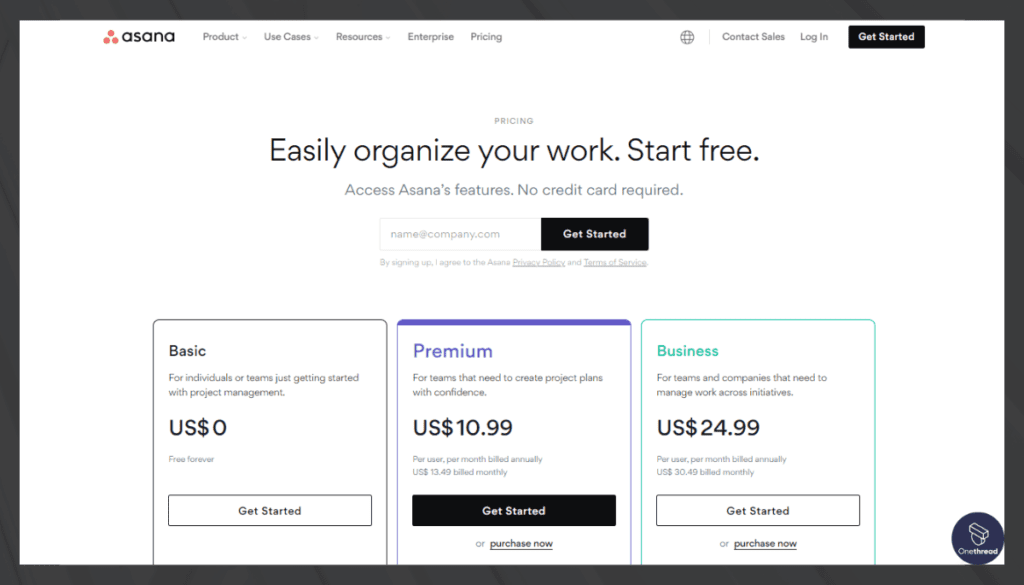
- Free Plan: Basic functionality, suitable for small teams
- Premium Plan: $10.99/user/month, including advanced features and customization
- Business Plan: $24.99/user/month, designed for complex projects with additional tools
- Enterprise Plan: Custom pricing, tailored for large organizations
Is Asana Better than nTask?
Asana’s strength lies in its versatile approach to project management, catering to diverse needs through its wide range of features.
While nTask is feature-rich, Asana’s flexibility, customizability, and robust reporting make it an attractive option for teams seeking a more personalized project management experience.
Our Review of Asana
Asana stands out for its blend of user-friendliness and powerful functionality. Whether managing simple tasks or complex projects, its range of features and customization options make it adaptable to various team needs.
While the learning curve may be steeper for some, its versatility and integration capabilities make it a compelling choice for those seeking an all-encompassing solution for project management, earning it high praise in the industry.
Monday.com
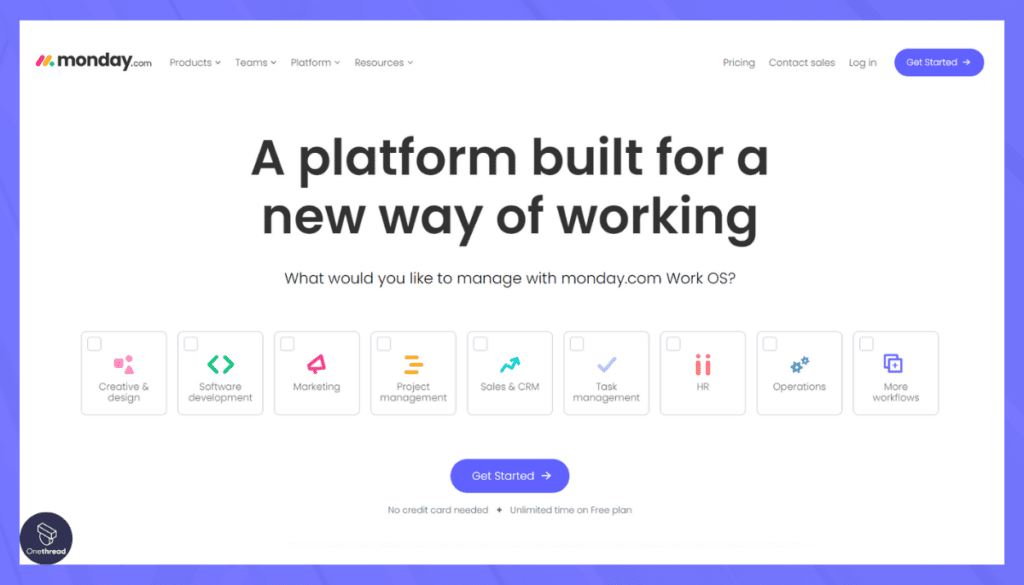
Monday.com is a highly customizable project management platform that emphasizes visual and intuitive planning. Renowned for its color-coded board system, it provides teams with a clear, visual snapshot of ongoing projects.
Monday.com facilitates collaboration, prioritization, and tracking of tasks, making it a sought-after tool for businesses of all sizes. The platform’s ease of use and flexibility are key to its growing popularity.
Features of Monday.com
Visual Board Management
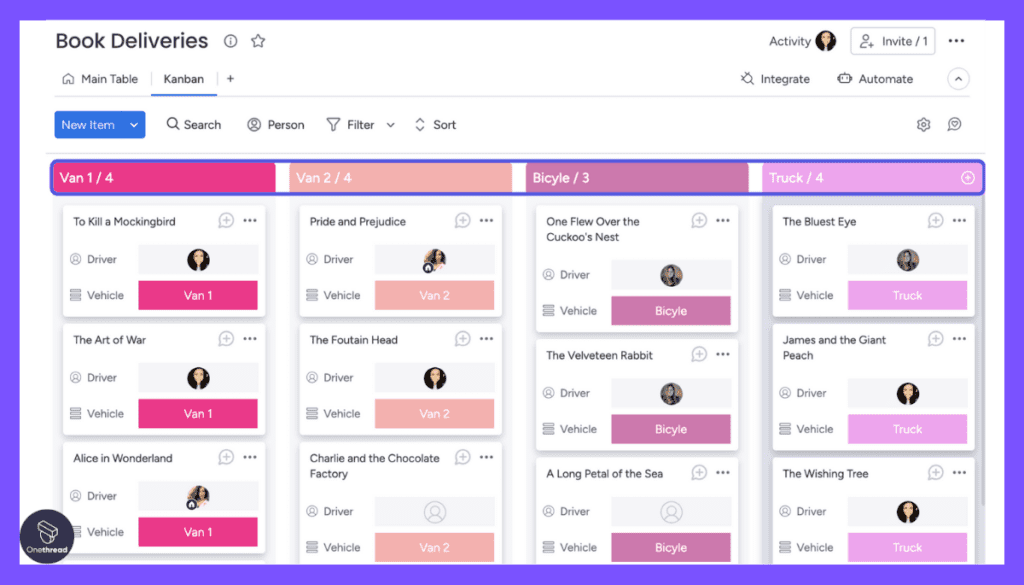
Monday.com utilizes a visual approach to board management, where tasks are organized into customizable boards. Each board displays tasks and status updates using color-coded labels, offering an immediate overview of project progress, task statuses, and upcoming deadlines.
This visual representation enhances team understanding and decision-making by presenting information in an easily digestible format.
Automation and Integration
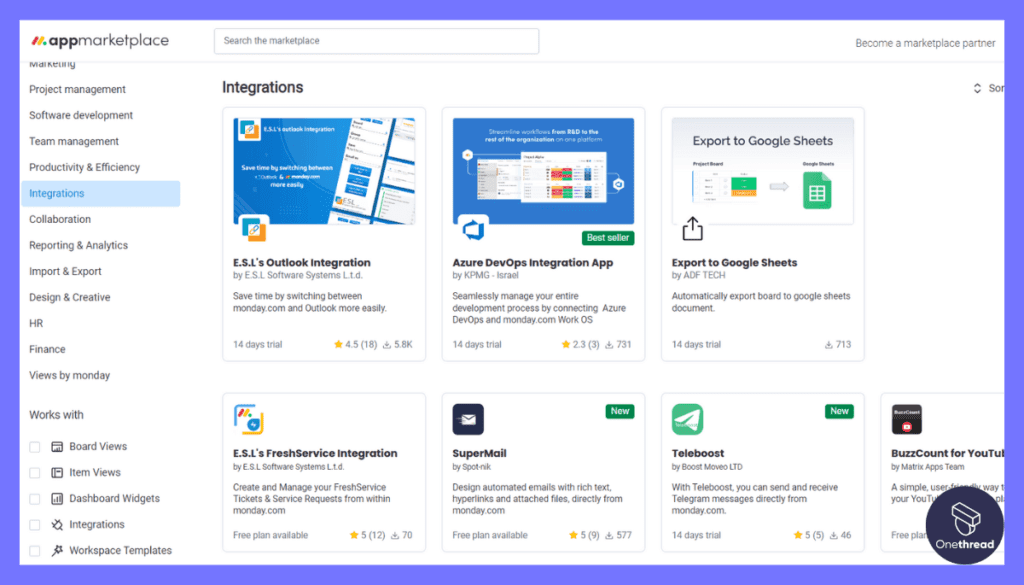
Monday.com offers automation features that streamline workflows by automating routine tasks and processes. This feature reduces manual workloads and improves efficiency.
Additionally, its integration capabilities enable seamless connections with various third-party tools and applications.
Customizable Workflows
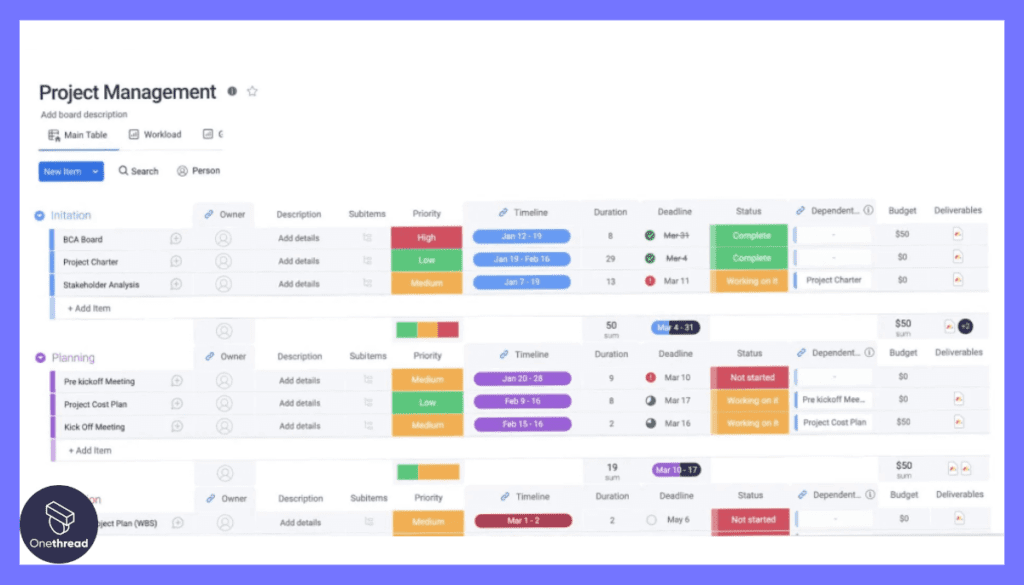
The ability to build and customize workflows in Monday.com is a significant advantage. Teams can design workflows tailored to their specific needs, aligning the platform with their unique processes.
This customization adds flexibility and adaptability to project management, allowing teams to follow their preferred methodologies.
Real-Time Collaboration
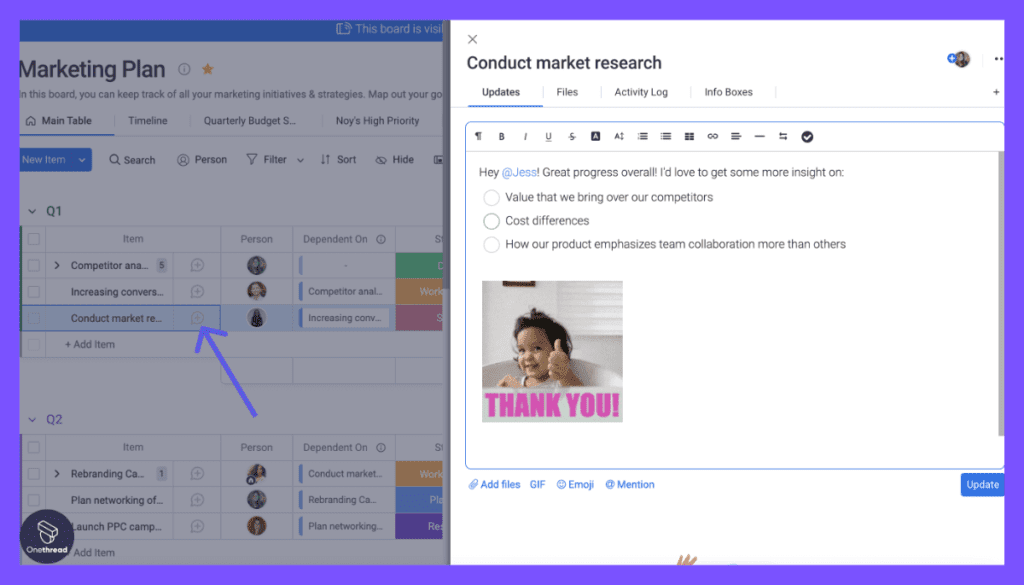
Collaboration is at the core of Monday.com. The platform facilitates real-time communication and collaboration among team members.
This real-time aspect ensures that updates, comments, and discussions are instant, reducing communication delays and preventing information silos.
Pros and Cons of Using Monday.com
Pros
- Highly visual and intuitive interface
- Robust automation and integration capabilities
- Suitable for all types of projects
- Scalable to various team sizes
Cons
- Can be pricey for small businesses
- May require training for more complex setups
Pricing
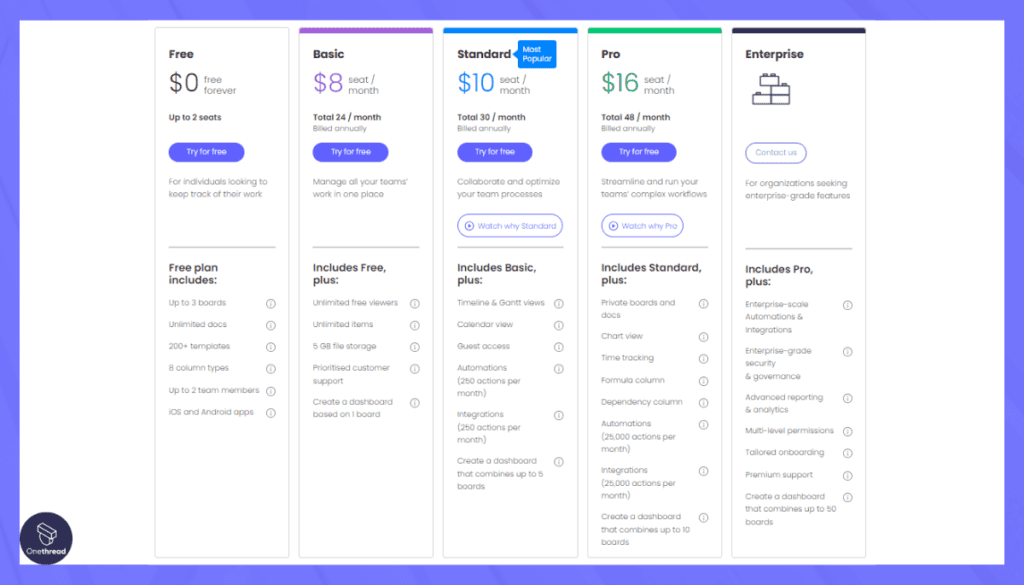
- Individual Plan: Free with limited features
- Basic Plan: $8/user/month, for small teams
- Standard Plan: $10/user/month, additional features and integrations
- Pro Plan: $16/user/month, full range of functionalities
- Enterprise Plan: Custom pricing, tailored solutions for large organizations
Customer Ratings
- G2: 4.7 (8,280+ reviews)
- Capterra: 4.6/5 (4,069+ reviews)
Is Monday.com Better than nTask?
Monday.com’s appeal lies in its visual approach and customizability, offering a distinctive experience compared to nTask.
While both tools have strong features, Monday.com’s emphasis on visual management and adaptability make it a favorite for teams that prefer a more visual and engaging way to manage their projects.
Our Review of Monday.com
Monday.com is praised for its visually engaging design and robust customization features. Its color-coded boards make project tracking a breeze, and its adaptability ensures that teams of all sizes can benefit from its functionalities.
While pricing may be a concern for smaller teams, its robust features and seamless integrations make it a valuable tool for those looking to manage projects with clarity and efficiency. It’s a strong contender in the project management landscape.
Wrike
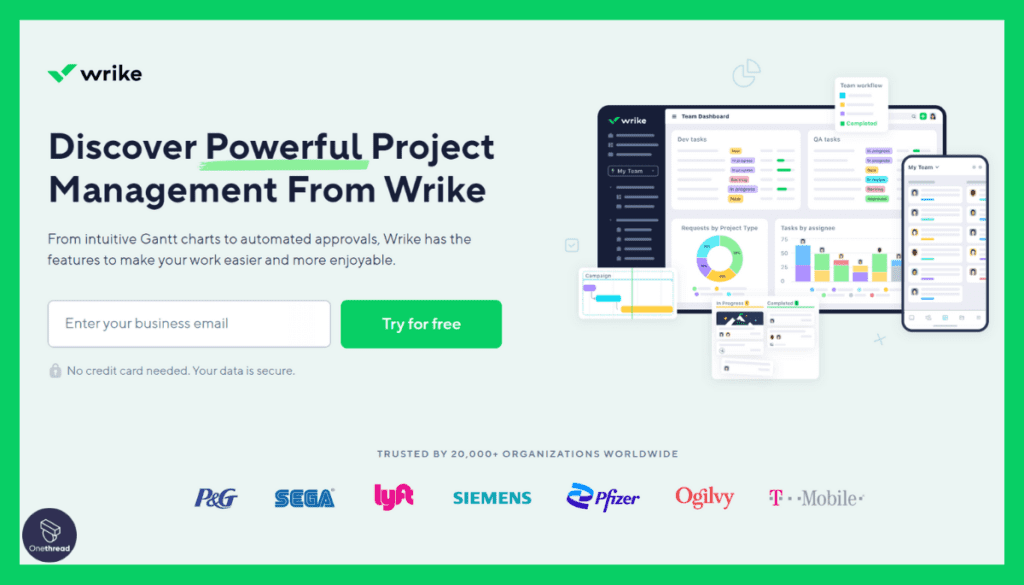
Wrike is a versatile project management tool designed to enhance collaboration and efficiency within teams. Offering a blend of traditional project management features with modern collaboration capabilities, Wrike caters to both small teams and large enterprises.
Its real-time updates, advanced reporting tools, and customizable dashboards make it a comprehensive solution for various project management needs.
Features of Wrike
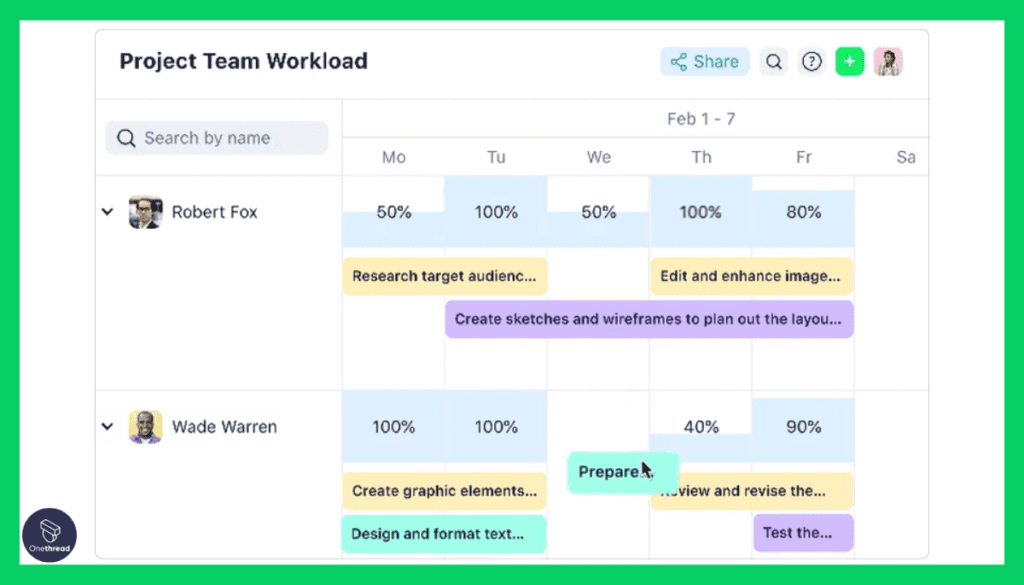
Dynamic Request Forms
Wrike’s dynamic request forms simplify and standardize the process of receiving project requests. These forms allow team members to submit requests with all the necessary information upfront, reducing back-and-forth communication and ensuring that crucial details are not overlooked. This streamlined intake process speeds up the initiation of new projects.
Interactive Gantt Charts
Wrike’s interactive Gantt charts offer a visual representation of project timelines, tasks, and dependencies. This visual tool aids in project planning, tracking, and management by providing a clear overview of how tasks are interconnected and their scheduled progression. Gantt charts help prevent bottlenecks and optimize resource allocation.
Collaborative Workspaces
Wrike’s collaborative workspaces create shared areas where team members can work together, communicate, and store all relevant project materials in one centralized location.
This feature promotes effective teamwork, reduces the need to search for information across different platforms, and ensures that everyone stays aligned and engaged.
Performance Analytics
Wrike’s performance analytics provide valuable insights into project progress and team efficiency. Managers can monitor various performance metrics, track task completion rates, and analyze results.
These insights enable data-driven decision-making, allowing managers to make informed adjustments to keep projects on track and optimize workflows.
Pros and Cons of Using Wrike
Pros
- Flexible and customizable to various workflows
- Strong integration with other tools
- Robust reporting and analytics
- Supports Agile methodologies
Cons
- Can be complex for beginners
- Premium features may be expensive for smaller teams
Pricing
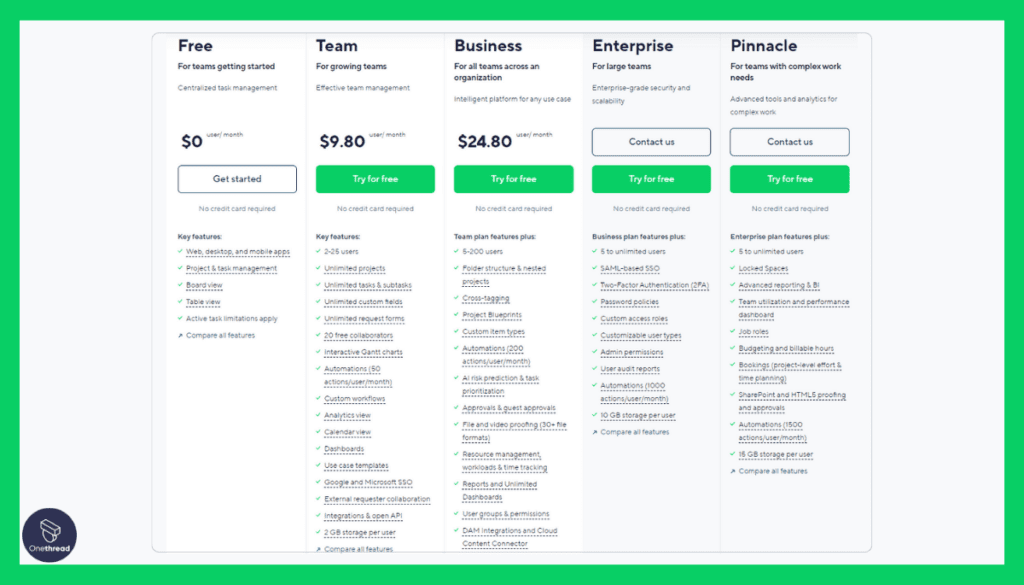
- Free Plan: Basic features, suitable for small teams
- Professional Plan: $9.80/user/month, includes integrations and additional functionalities
- Business Plan: $24.80/user/month, designed for complex projects with advanced tools
- Enterprise Plan: Custom pricing, tailored to the specific needs of large organizations
Customer Ratings
- G2: 4.2 (3,464+ reviews)
- Capterra: 4.3 (2,439+ reviews)
Is Wrike Better than nTask?
Wrike’s powerful feature set, including dynamic request forms, Gantt charts, and collaboration spaces, offer unique benefits that stand out in comparison to nTask.
While nTask provides robust functionality, Wrike’s emphasis on customization and advanced analytics may make it a more suitable choice for teams needing detailed insights and flexible project management options.
Our Review of Wrike
Wrike stands as a robust project management platform offering flexibility and a rich feature set. Its adaptability to various project methodologies, along with strong integration capabilities, makes it suitable for diverse team needs.
While there may be a learning curve for some, the advanced tools and analytics make it a worthwhile investment for those looking for an all-in-one solution. Wrike’s reputation as a comprehensive project management tool is well-deserved.
ClickUp
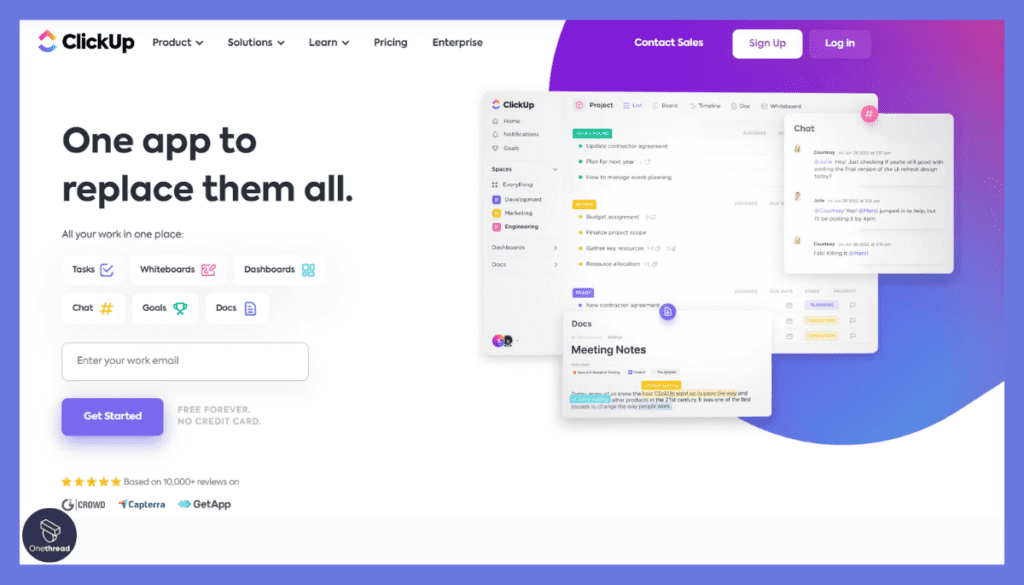
ClickUp is a rapidly growing project management platform known for its all-in-one functionality and adaptability. It aims to replace multiple workplace apps by bringing various functionalities into one platform.
From task management to time tracking, ClickUp offers a broad array of features that cater to various organizational needs. Its blend of simplicity, customization, and extensive features makes it a favorite among diverse teams.
Features of ClickUp
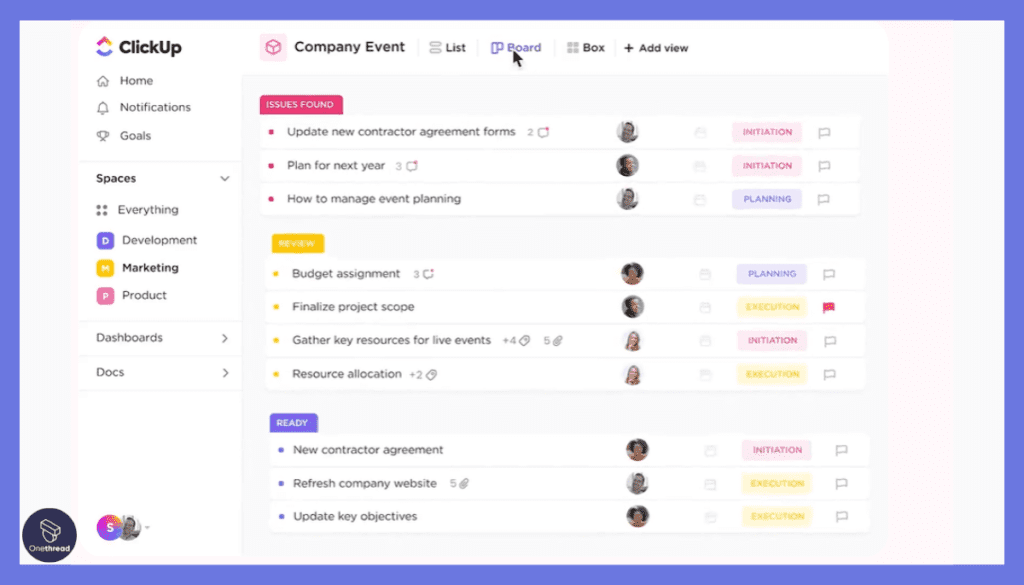
Hierarchical Structure
ClickUp’s hierarchical structure allows for a granular organization of tasks, subtasks, and projects. This feature provides teams with a clear roadmap of their projects, breaking down responsibilities into manageable components. The ability to create nested tasks and subtasks ensures that teams can maintain a structured and organized approach to their work.
Custom Views
ClickUp offers the flexibility to create custom views based on how users prefer to visualize their projects. Whether it’s the List view for a detailed task list, the Board view for a Kanban-style workflow, or the Gantt chart for timeline planning, teams can choose the view that suits their needs. This customizable approach enhances user experience and aligns with various project management methodologies.
Time Tracking
ClickUp’s time tracking feature plays a crucial role in managing project timelines and budgets. Team members can log hours worked, estimate task durations, and manage overall capacity.
Accurate time tracking ensures that projects progress according to plan and remain within budget constraints, contributing to project success.
Automation and Integration
ClickUp’s automation capabilities streamline workflows by automating repetitive tasks and actions. This not only saves time but also ensures consistency in processes.
Additionally, ClickUp integrates with various third-party apps and tools, allowing seamless data flow between platforms and tools. Integration enhances collaboration and minimizes the need to switch between different tools.
Pros and Cons of Using ClickUp
Pros
- Highly customizable and adaptable
- Comprehensive features in one platform
- Affordable pricing
- User-friendly interface
Cons
- May be overwhelming with so many features
- Some users report occasional bugs
Pricing
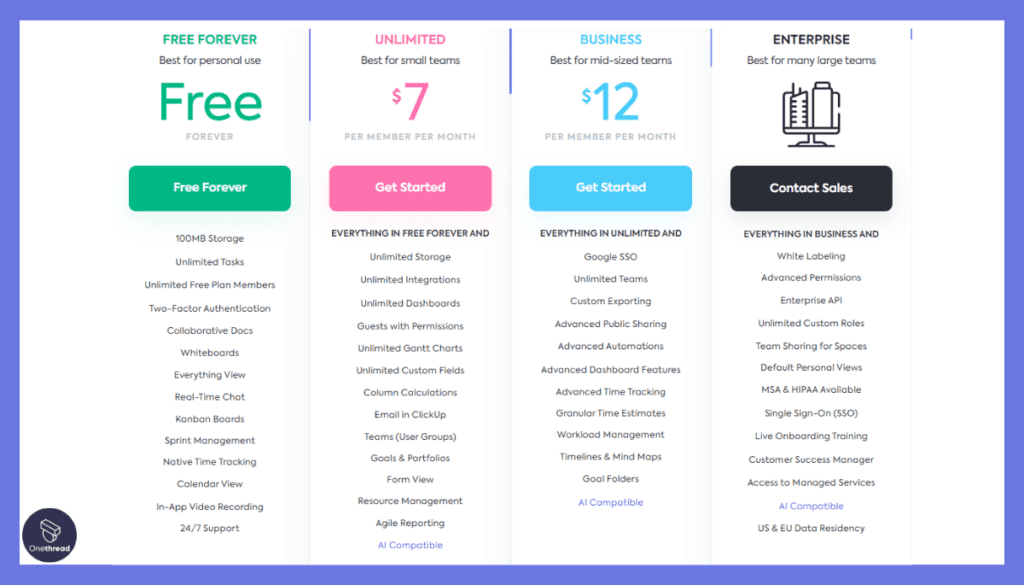
- Free Plan: Unlimited tasks and users, with some feature limitations
- Unlimited Plan: $5/user/month, offers more customization and integrations
- Business Plan: $9/user/month, includes advanced features and reporting
- Enterprise Plan: Custom pricing, tailored solutions for complex needs
Customer Ratings
- G2: 4.7 (8,516+ reviews)
- Capterra: 4.7 (3,744+ reviews)
Is ClickUp Better than nTask?
ClickUp’s strength lies in its ability to bring various functionalities into one platform, offering an extensive range of features without the need for multiple tools.
While nTask has its own merits, ClickUp’s customization, adaptability, and comprehensive offerings may make it a preferable option for teams looking for an all-encompassing project management solution.
Our Review of ClickUp
ClickUp has made waves in the project management scene for its ability to replace multiple apps with one comprehensive platform. Its custom views, hierarchical structure, and extensive feature set make it an attractive option for teams of all sizes.
While some may find the abundance of features overwhelming, its flexibility and pricing make it a strong contender in the field. ClickUp successfully fulfills the promise of being a one-stop solution for project management needs.
Jira
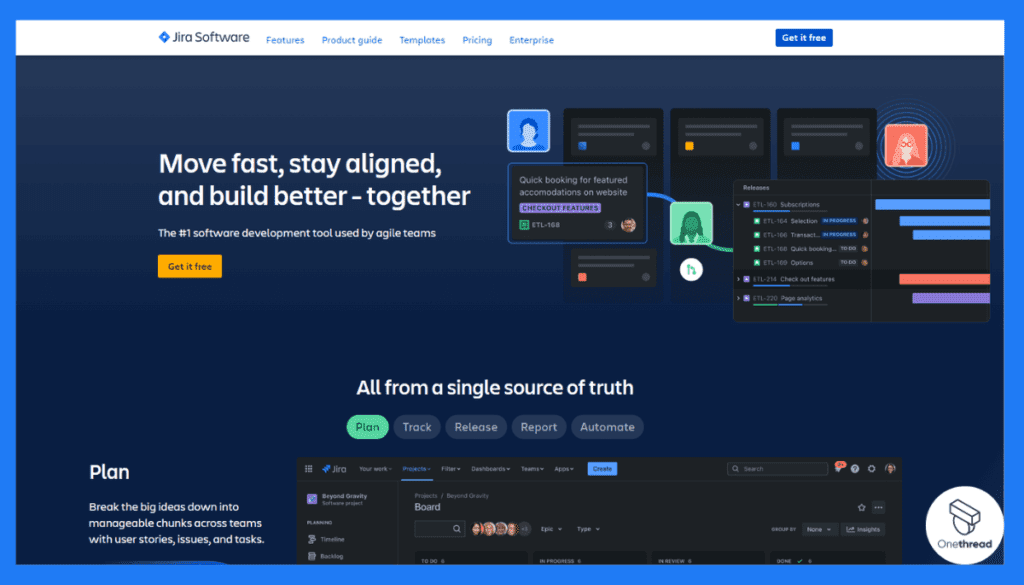
Jira, developed by Atlassian, is a well-known project management tool particularly favored in the software development industry. It offers robust features for issue and project tracking, making it an essential tool for Agile teams.
With various customization options, powerful reporting capabilities, and a focus on collaboration, Jira caters to both small startups and large enterprises, providing a comprehensive solution for development workflows.
Features of Jira
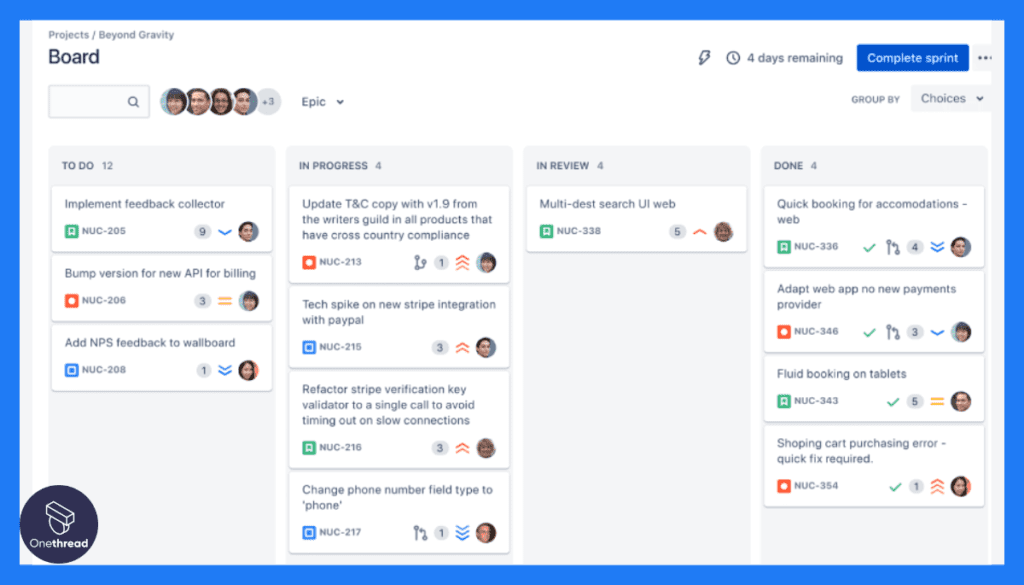
Agile Project Management
Jira’s Agile project management capabilities are a cornerstone of its functionality. The platform supports various Agile methodologies such as Scrum and Kanban, enabling teams to organize their work into sprints, manage backlogs, and visualize progress through Agile boards.
This flexibility promotes iterative development and allows teams to adapt to changing requirements efficiently.
Issue and Bug Tracking
Jira excels in issue and bug tracking, helping teams log, prioritize, and assign tasks and defects. The comprehensive issue tracking system ensures that all development issues are captured, managed, and resolved in a structured manner. This feature contributes to improved software quality and faster resolution times.
Customizable Workflows
Jira’s workflows are customizable, allowing teams to define and adapt their processes according to project requirements. Workflows can be tailored to match specific stages and steps in development, testing, and deployment. Customization ensures that the tool aligns precisely with the team’s preferred development methodology.
Advanced Reporting and Analytics
Jira offers powerful reporting and analytics tools that provide insights into team performance, project health, and productivity metrics. The ability to generate customized reports and dashboards allows teams to measure progress, identify bottlenecks, and make informed decisions for continuous improvement.
Pros and Cons of Using Jira
Pros
- Highly customizable to fit various workflows
- Strong support for Agile methodologies
- Extensive integration with other Atlassian products
- In-depth reporting and tracking
Cons
- Can be complex for non-developers
- Pricing may be high for small teams
Pricing
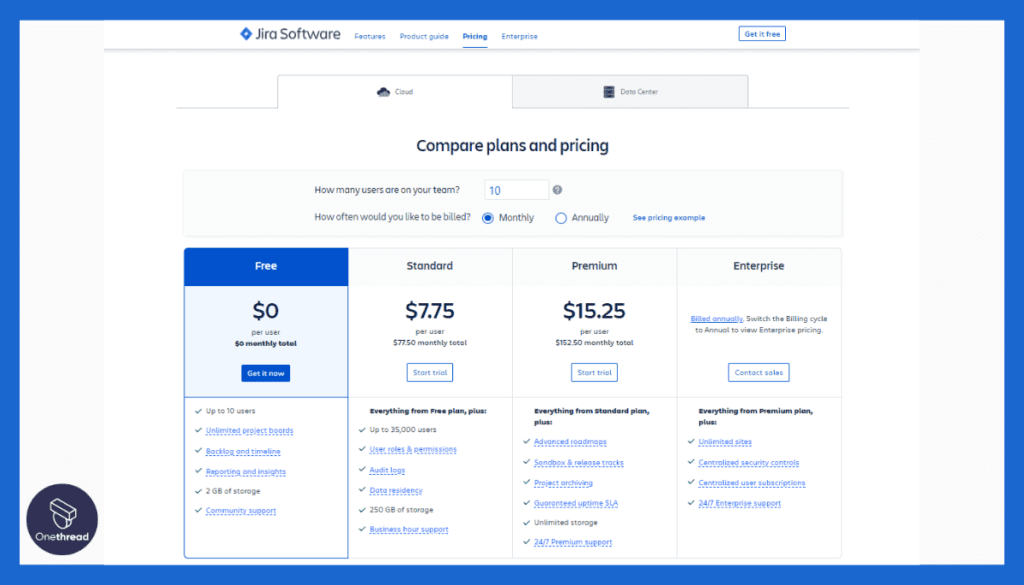
- Free Plan: Limited features, suitable for small teams
- Standard Plan: $7/user/month, offers more functionalities and support
- Premium Plan: $14/user/month, includes advanced features and 24/7 support
- Enterprise Plan: Custom pricing, tailored for large-scale needs
Customer Ratings
- G2: 4.3 (5,442+ reviews)
- Capterra: 4.4 (13251 reviews)
Is Jira Better than nTask?
Jira stands out with its strong focus on software development and support for Agile methodologies, making it a distinctive choice compared to nTask.
While both platforms offer robust project management features, Jira’s specialization in development workflows, customization, and advanced analytics may make it more suitable for software development teams.
Our Review of Jira
Jira has earned its reputation as a leading tool in the software development sector, offering comprehensive features tailored to Agile teams. Its robust tracking, customizable workflows, and integration capabilities make it a top choice for development projects.
While it may present a learning curve for non-developers, its powerful functionalities make it worth the investment for those in need of an intricate, development-centric project management tool. Its specialized focus sets it apart in the project management landscape.
Zoho Projects
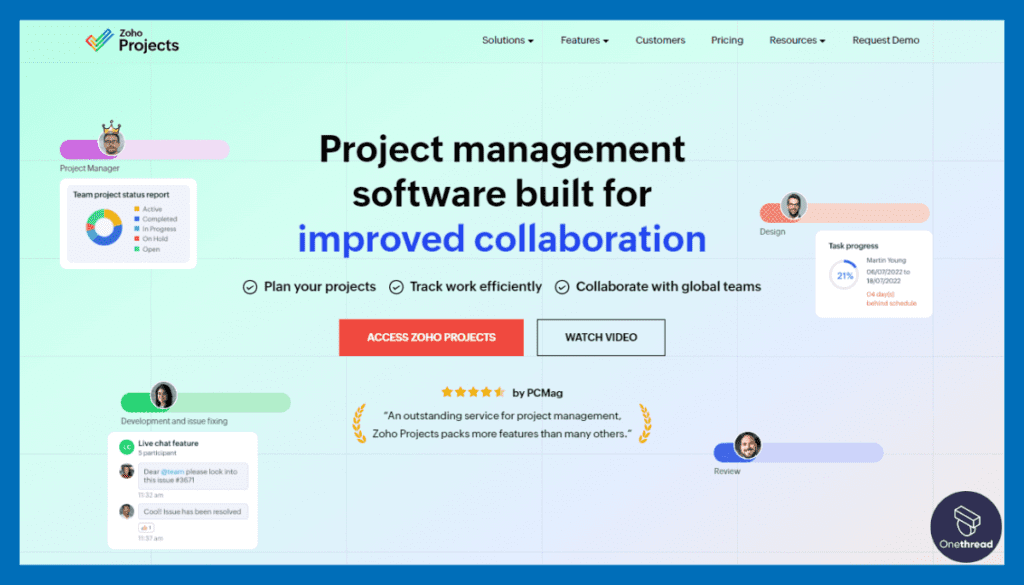
Zoho Projects is part of Zoho’s extensive suite of business applications and offers a well-rounded project management solution. Known for its ease of use and robust set of features, it provides businesses with the tools needed to plan, track, and collaborate on projects efficiently.
Catering to a wide range of industries, Zoho Projects strikes a balance between functionality and user-friendliness, making it a popular choice for various team sizes and project types.
Features of Zoho Projects
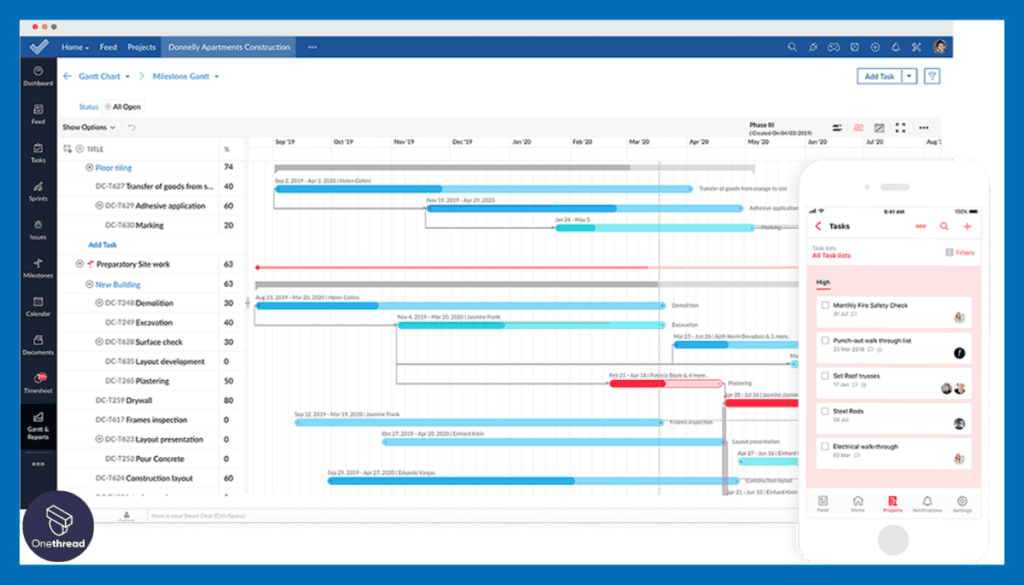
Task Management
Zoho Projects offers a comprehensive task management system that empowers teams to create, assign, and track tasks, subtasks, and milestones. This feature ensures that everyone knows their responsibilities, deadlines, and the overall progress of the project.
The ability to break down tasks into subtasks allows for a more granular approach to project planning and execution.
Time Tracking and Billing
Zoho Projects integrates time tracking and billing functionalities into its platform. This feature assists in monitoring work hours accurately, enabling teams to track time spent on tasks and projects.
Integrated billing capabilities make it easier to generate invoices based on tracked time, streamlining the financial aspects of project management and client billing.
Collaboration Tools
Zoho Projects emphasizes collaboration by providing tools that facilitate teamwork and communication. Shared documents, forums, and commenting features encourage open communication within the team.
This collaboration ecosystem ensures that team members can share updates, ideas, and feedback, fostering a collaborative and productive work environment.
Reporting and Analytics
Zoho Projects offers robust reporting and analytics tools that provide insights into project performance, resource allocation, and overall project health. Customizable reports allow teams to assess progress, identify potential bottlenecks, and make data-driven decisions to improve efficiency and outcomes.
Pros and Cons of Using Zoho Projects
Pros
- Intuitive and user-friendly interface
- Integration with other Zoho products and third-party apps
- Affordable pricing for various features
- Good support for mobile devices
Cons
- Customization can be limited in lower-tier plans
- Some users may find the interface less visually engaging
Pricing
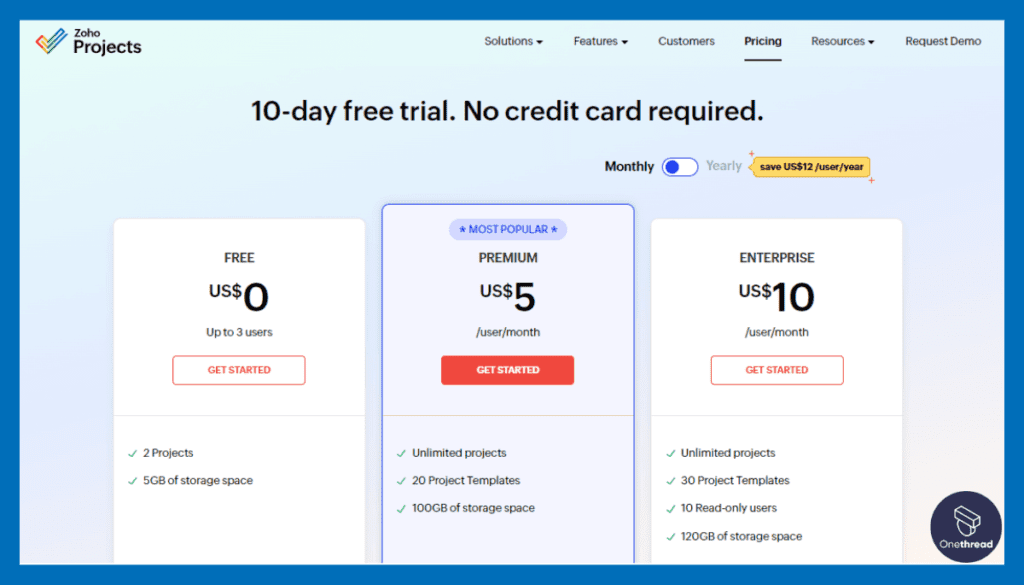
- Free Plan: Up to 3 users, limited features
- Standard Plan: $3/user/month, essential features
- Express Plan: $4/user/month, additional tools for medium-sized teams
- Premium Plan: $5/user/month, comprehensive features
- Enterprise Plan: Custom pricing, tailored solutions
Customer Ratings
- G2: 4.3 (371+ reviews)
- Capterra: 4.3 (365+ reviews)
Is Zoho Projects Better than nTask?
Zoho Projects offers a broad set of features, coupled with an intuitive interface, making it an appealing option compared to nTask.
Its integration capabilities with other Zoho apps, affordable pricing, and focus on collaboration may make it a more favorable choice for businesses seeking a balance between functionality and ease of use.
Our Review of Zoho Projects
Zoho Projects stands as an efficient and user-friendly project management tool, with its diverse functionalities and integration options. Its affordability without compromising essential features makes it a strong contender for teams of various sizes.
While there might be some limitations in customization, the overall ease of use and comprehensive feature set make it a reliable choice. Zoho Projects proves to be a valuable asset in the ever-competitive world of project management.
Basecamp
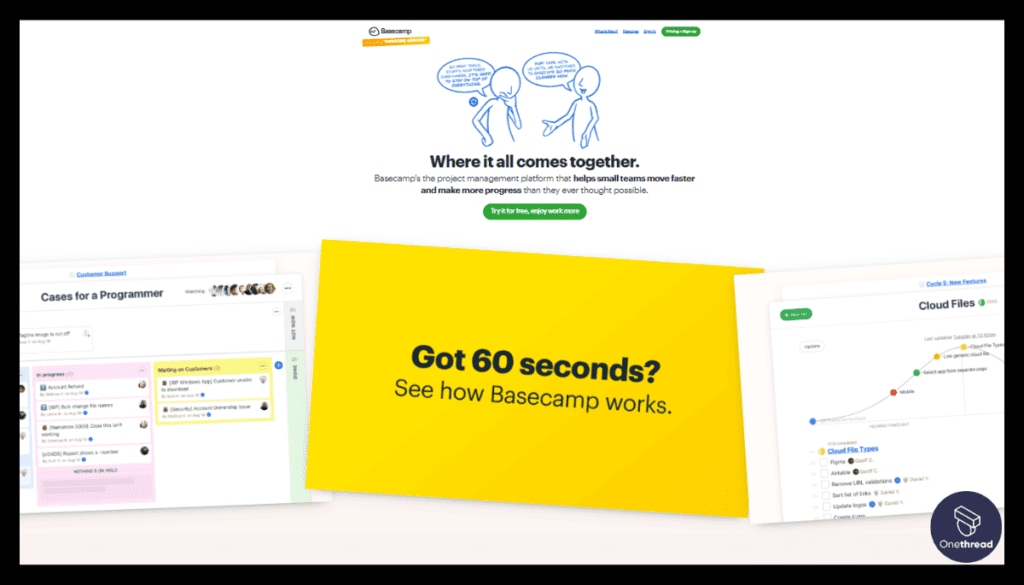
Basecamp is a pioneer in the project management arena, known for its straightforward approach to collaboration and task organization. It simplifies project management by consolidating everything into one place, from tasks and schedules to files and conversations.
With a focus on ease of use, it’s designed to facilitate collaboration for teams of all sizes without overwhelming them with complex features. Its unique blend of simplicity and functionality has made Basecamp a favored choice across various industries.
Features of Basecamp
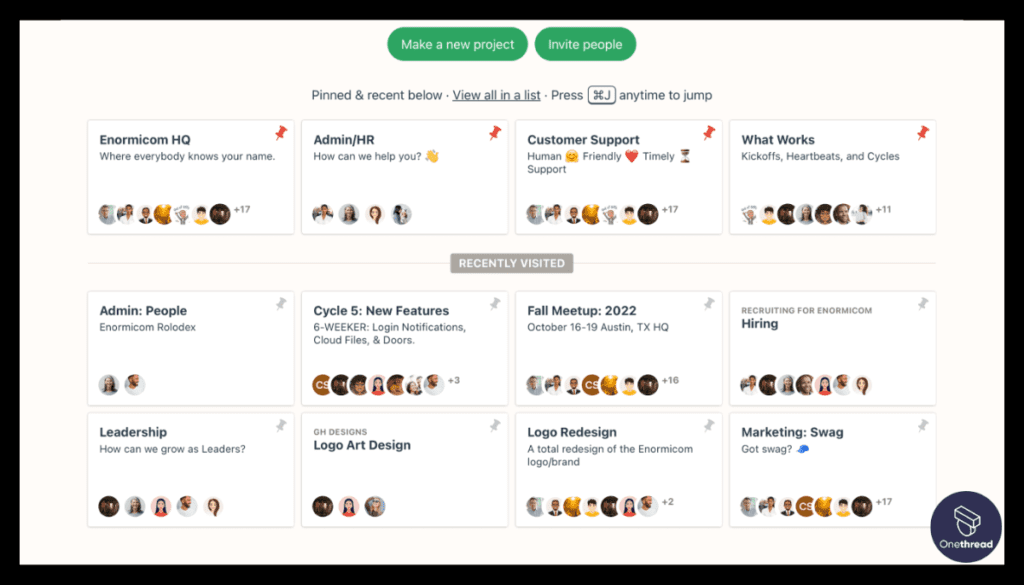
To-do Lists
Basecamp’s to-do lists provide a structured and organized way to manage tasks. Team members can create, assign, and track tasks, ensuring that responsibilities are clear and progress is visible. To-do lists help team members stay on top of their tasks and contribute to overall project success.
Message Boards and Chat
Basecamp integrates message boards and real-time chat, offering a centralized communication hub for teams. Message boards facilitate discussions, updates, and announcements, keeping communication transparent and organized. Real-time chat supports instant communication, making it easy for team members to collaborate on urgent matters.
Scheduling and Deadlines
Basecamp’s scheduling tools allow teams to set and track deadlines, ensuring that projects progress according to planned timelines. By keeping everyone aligned on milestones and due dates, Basecamp helps prevent delays and ensures that projects are delivered on time.
File and Document Sharing
Basecamp simplifies file and document sharing. Team members can upload and share files, ensuring that necessary resources are easily accessible to everyone involved. This feature promotes information sharing, reduces email clutter, and maintains a centralized repository of project-related documents.
Pros and Cons of Using Basecamp
Pros
- Simple and intuitive design
- All-in-one collaboration platform
- Fixed pricing for unlimited users
- Strong focus on team communication
Cons
- Limited advanced features
- May not suit complex project needs
- Lack of built-in time tracking
Pricing
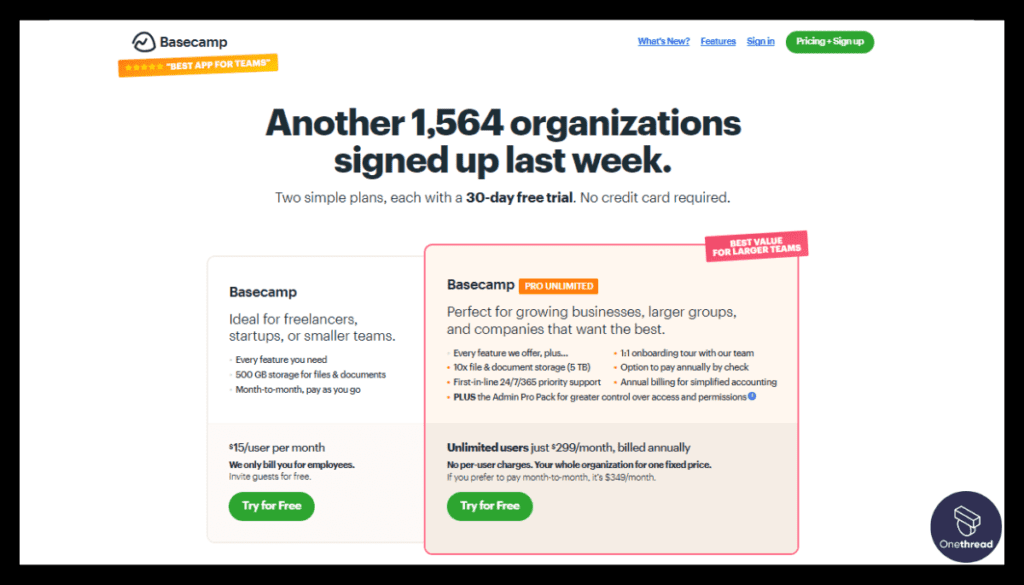
- Free Plan: Limited features, suitable for personal use
- Business Plan: $99/month, all features included, unlimited users
Customer Ratings
- G2: 4.1 (5,239+ reviews) ·
- Capterra: 4.3 (14,247+ reviews)
Is Basecamp Better than nTask?
Basecamp’s strength lies in its simplicity and focus on collaboration. While nTask offers more intricate project management functionalities, Basecamp’s all-in-one approach and fixed pricing may make it a more attractive option for teams prioritizing communication and straightforward task management.
It may especially appeal to those seeking an uncomplicated solution without a steep learning curve.
Our Review of Basecamp
Basecamp remains a strong player in the project management field, offering a simple yet effective solution for team collaboration and organization. Its emphasis on communication, coupled with an all-in-one platform design, makes it an appealing choice for many.
While it may lack some advanced features, its straightforward approach and reasonable pricing make it a go-to for teams looking for clarity and ease of use. Basecamp’s reputation as a user-friendly tool is well-earned.
Smartsheet
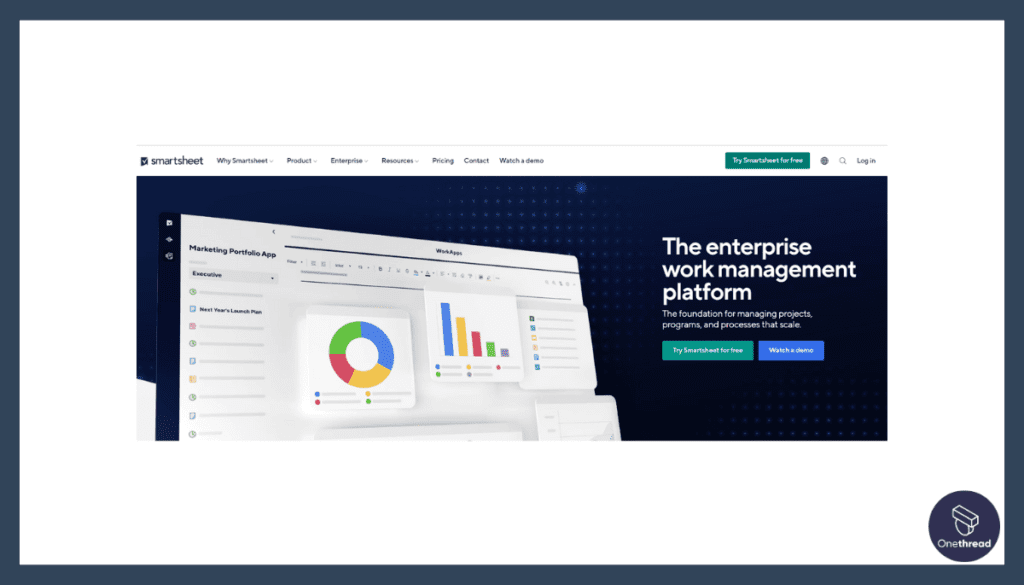
Smartsheet is a versatile platform that offers project management solutions with a spreadsheet-like interface. This unique approach combines the familiarity of spreadsheets with powerful collaboration and automation tools. Ideal for various project types, Smartsheet provides flexibility and scalability, catering to both small businesses and large enterprises.
It excels in workflow automation, resource management, and real-time collaboration, bridging the gap between traditional spreadsheets and modern project management software.
Features of Smartsheet
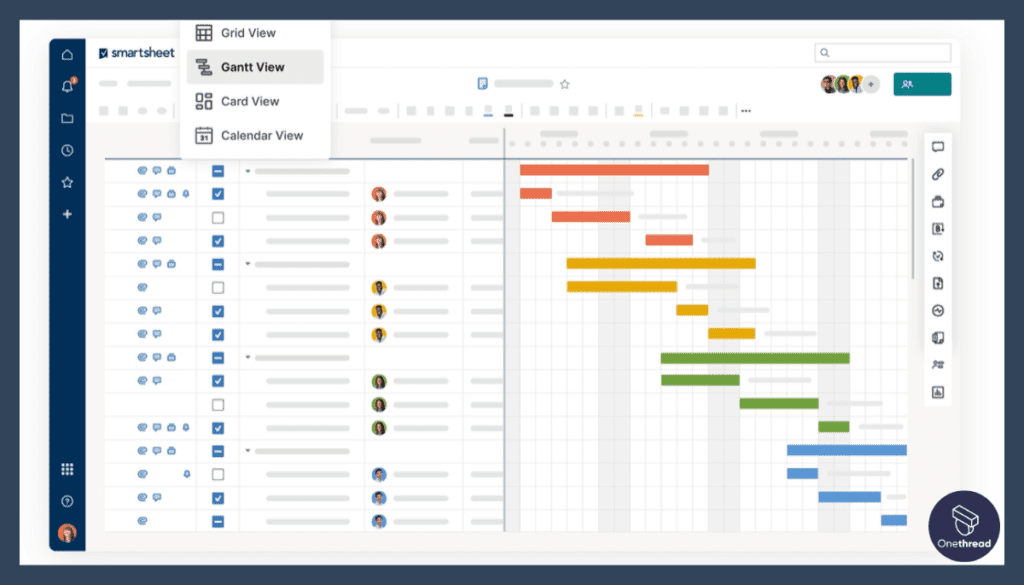
Grid View
Smartsheet’s grid view presents a familiar spreadsheet interface that simplifies project organization and customization. This feature allows users to structure and manage tasks, data, and information in a familiar tabular format. It’s particularly useful for teams comfortable with spreadsheet-based tools.
Automation and Workflow Integration
Smartsheet excels in automation and workflow integration. The platform’s automation capabilities reduce manual effort by automating repetitive tasks and processes.
Additionally, Smartsheet’s integration with other apps and tools streamlines data flow across various platforms, ensuring that information is up-to-date and accurate across systems.
Real-time Collaboration
Smartsheet supports real-time collaboration, allowing team members to work together on shared sheets simultaneously. This collaborative environment enhances productivity by facilitating instant communication, updates, and feedback. Team members can contribute to projects and make decisions in real time.
Reporting and Dashboards
Smartsheet offers robust reporting and dashboard features that provide valuable insights into project status, performance, and key metrics. Users can create customized reports and visual dashboards to monitor progress, analyze data trends, and make informed decisions based on real-time information.
Pros and Cons of Using Smartsheet
Pros
- Intuitive spreadsheet-like interface
- Strong automation and integration features
- Scalable for different business sizes
- Comprehensive reporting tools
Cons
- Can be overwhelming for spreadsheet novices
- Pricing might be steep for smaller teams
- Limited task management features in lower-tier plans
Pricing
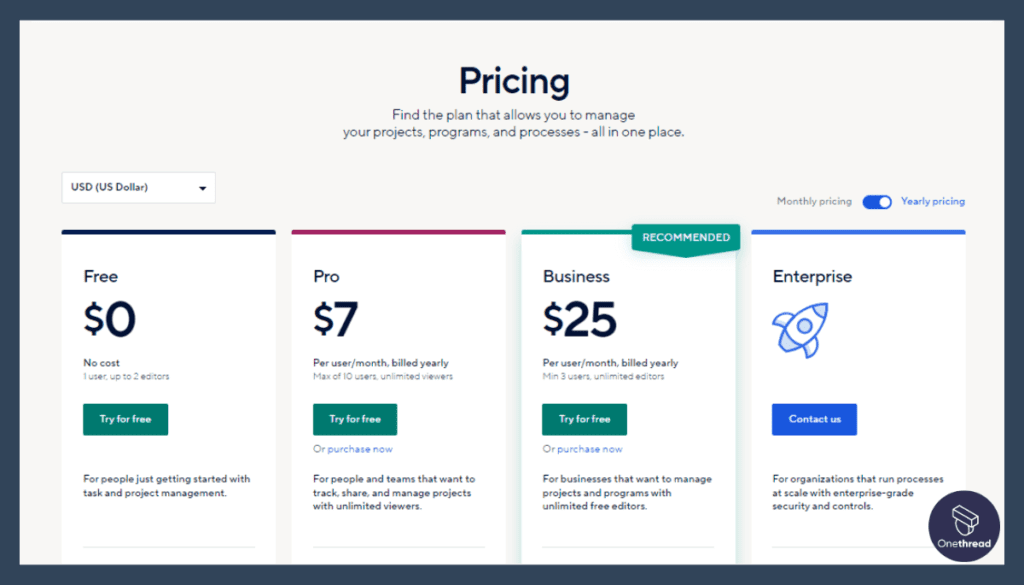
- Individual Plan: $14/month, suitable for personal use, limited features
- Business Plan: $25/user/month, includes automation, reporting, and more
- Enterprise Plan: Custom pricing, tailored solutions, and advanced capabilities
Customer Ratings
- G2: 4.4 (13,791+ reviews)
- Capterra: 4.5 (2,952+ reviews)
Is Smartsheet Better than nTask?
Smartsheet’s spreadsheet-based approach offers a unique take on project management, providing an intuitive yet powerful platform compared to nTask. Its robust automation, collaboration, and scalability make it suitable for diverse business needs.
While nTask has its own strengths, Smartsheet’s blend of traditional and modern features may be more appealing for those looking for spreadsheet familiarity with enhanced capabilities.
Our Review of Smartsheet
Smartsheet stands out with its unique blend of spreadsheet functionality and modern project management features. Its versatility and robust capabilities make it suitable for various industries and project types.
While the interface might present a learning curve for some, its powerful automation, collaboration, and reporting tools make it a worthy investment.
Smartsheet’s innovative approach to project management provides a flexible solution that adapts to a wide range of business needs.
Final Words
Choosing the right project management tool is crucial for effective collaboration, organisation, and timely project completion. The top 10 nTask alternatives provide a range of options catering to different needs and preferences.
Whether it’s the spreadsheet functionality of Smartsheet or the all-in-one collaboration focus of Basecamp, understanding the key differences and aligning them with your project requirements will ensure a successful selection.
Embrace the opportunity to explore these tools, and find the one that fits your team’s unique workflow and collaboration needs.
Frequently Asked Questions
Which nTask alternative is best for small businesses?
Tools like Trello and Basecamp offer user-friendly interfaces and cost-effective plans suitable for small businesses.
Can I integrate other tools with these nTask alternatives?
Yes, most of these alternatives offer integrations with popular tools like Slack, Google Workspace, and others, but availability may vary by plan.
Are there any free plans available among these alternatives?
Some tools like Basecamp and Trello offer free or limited-feature plans that can be suitable for personal use or small teams.
Do these alternatives provide Gantt chart views?
Most of the nTask alternatives provide Gantt chart views, except for some like Basecamp. This feature helps in visualising project timelines.
How secure are these project management tools?
Generally, these tools adhere to industry security standards and offer various security features, but it’s advised to review the specific security policies of each platform to ensure compliance with your requirements.
